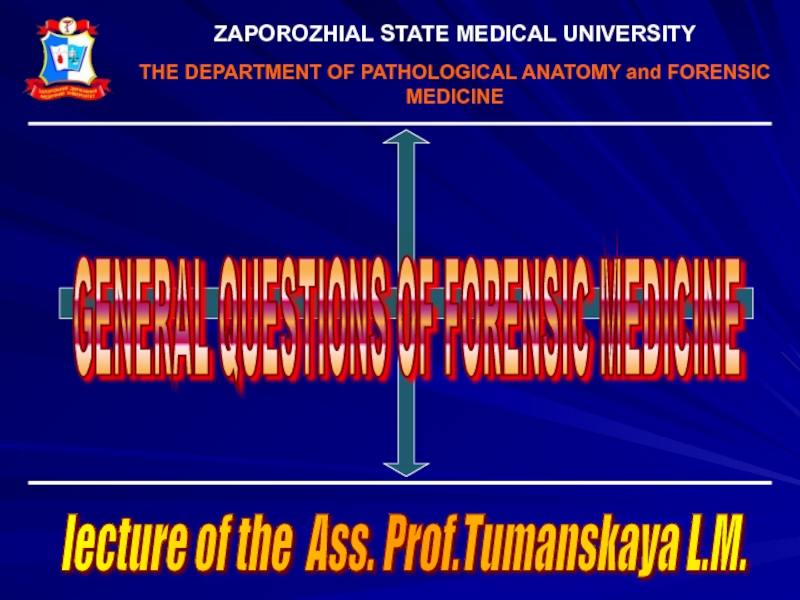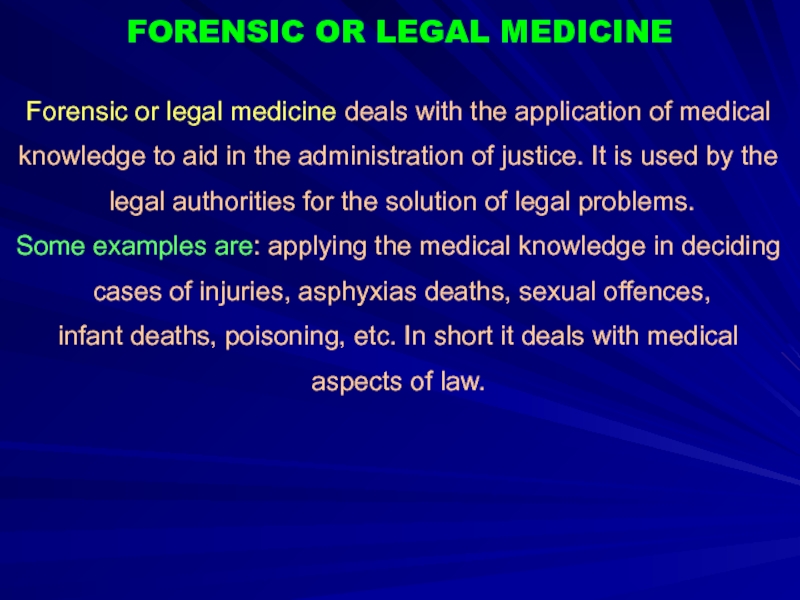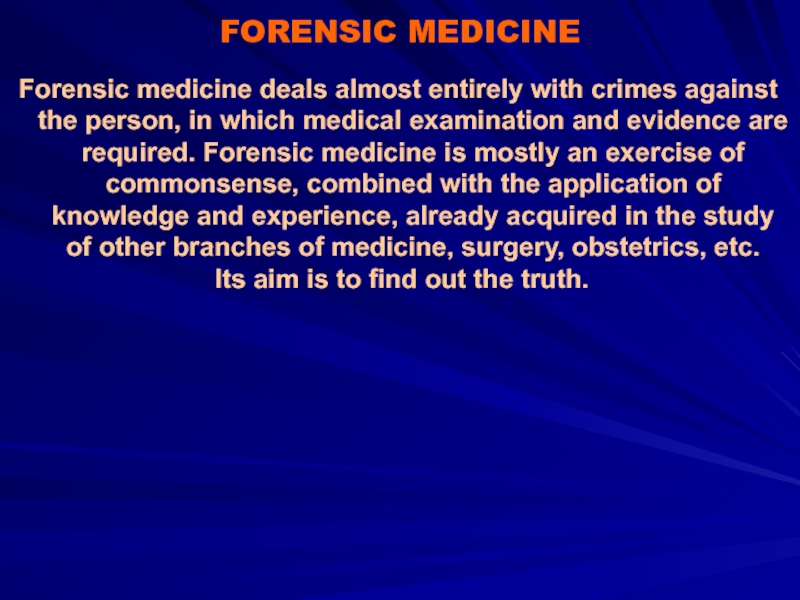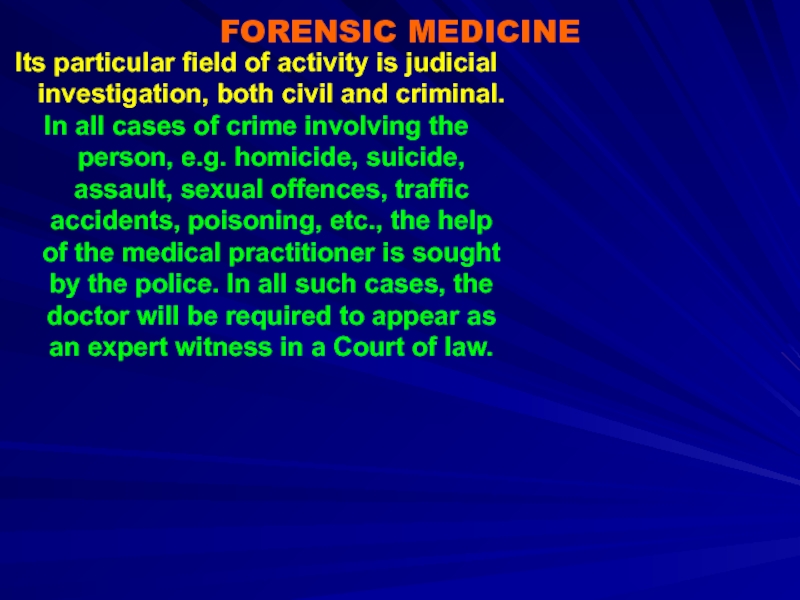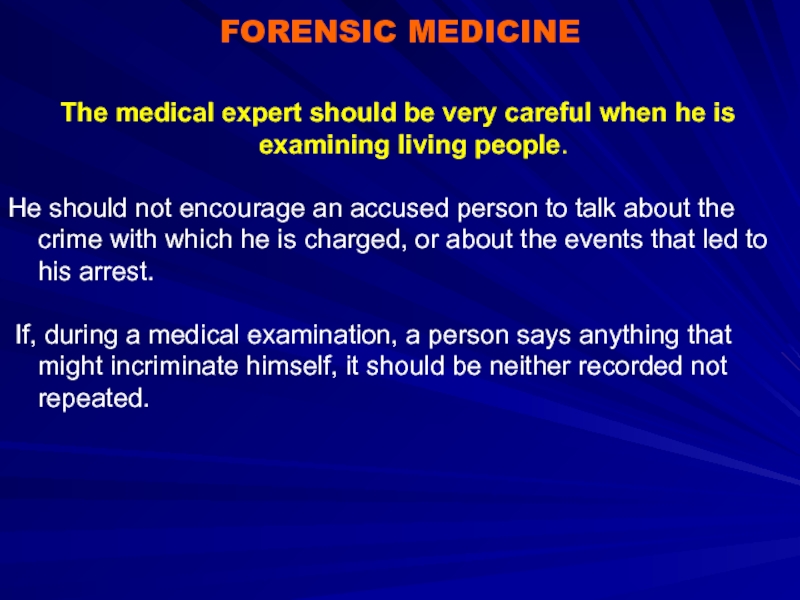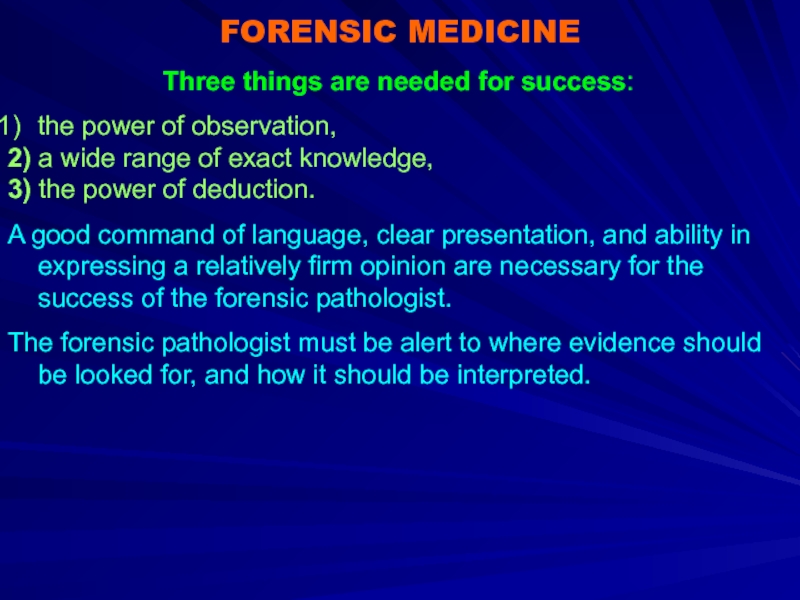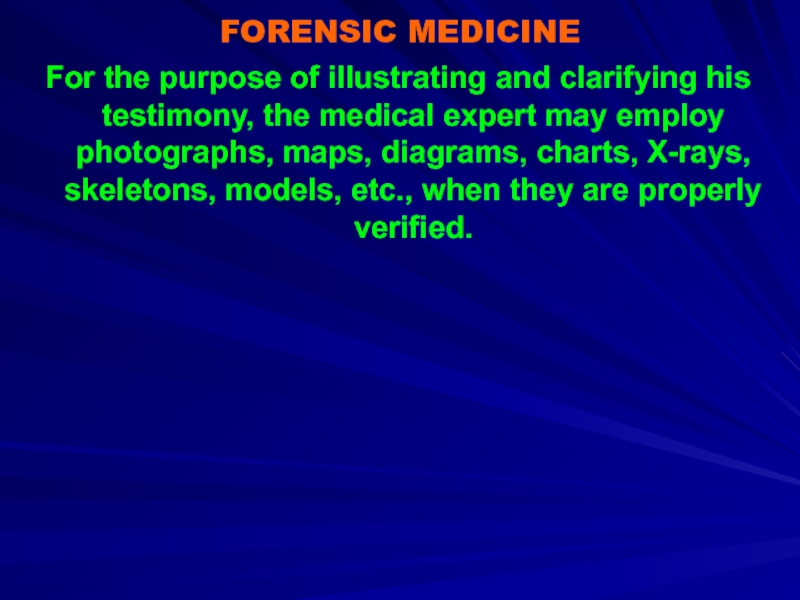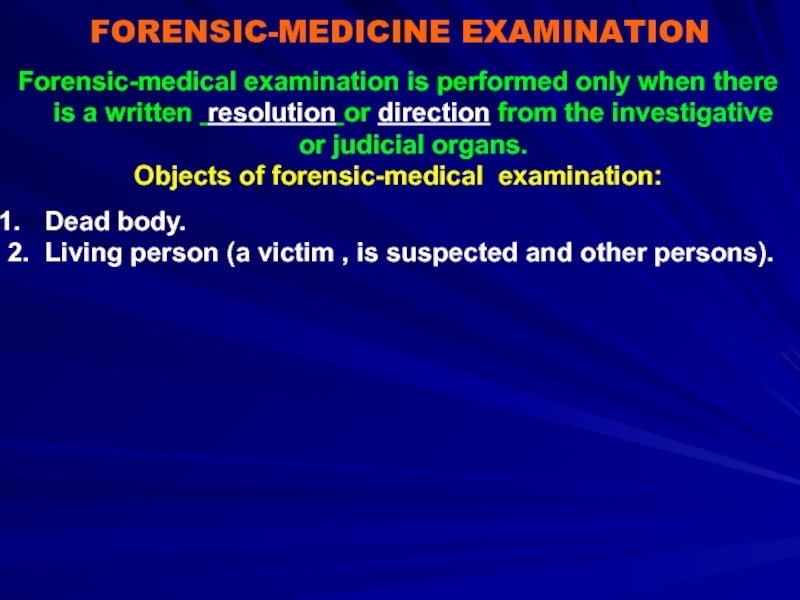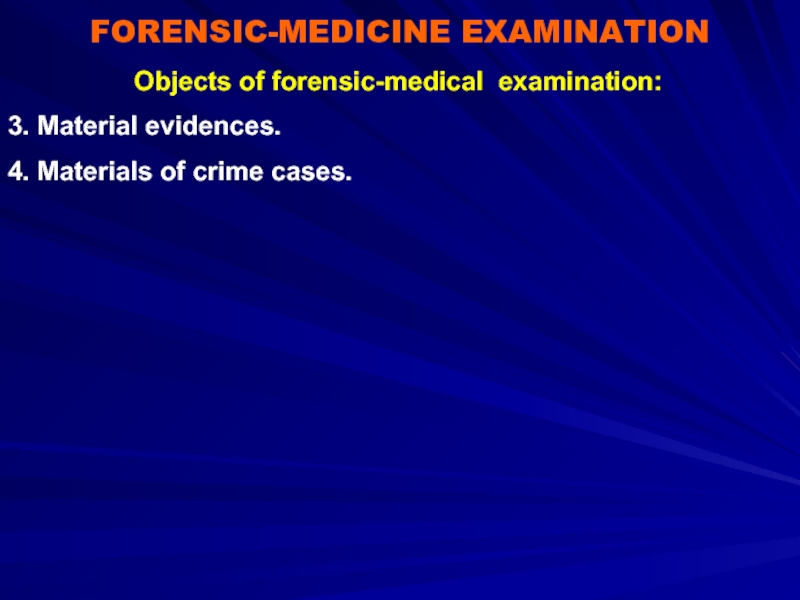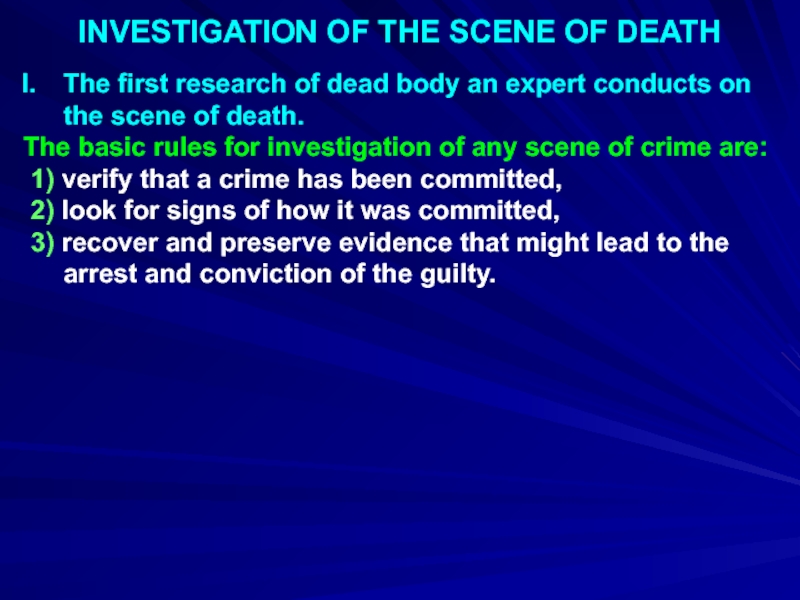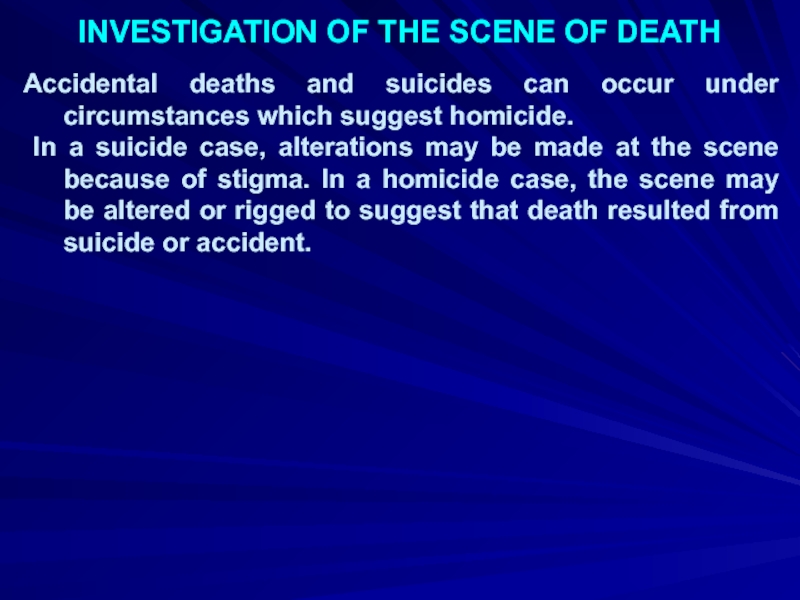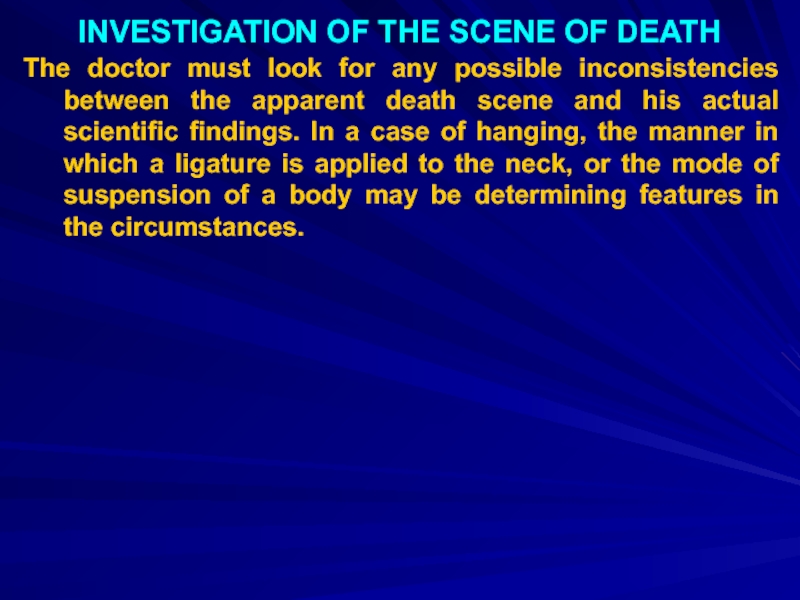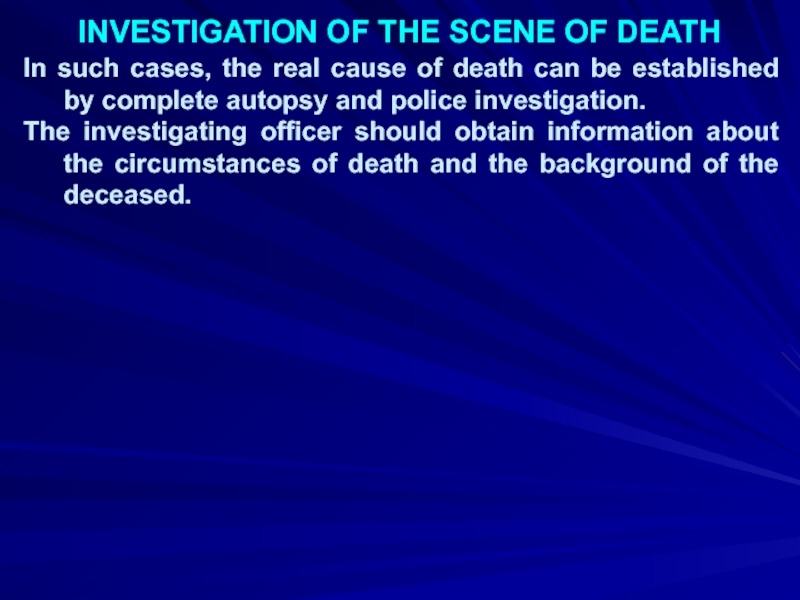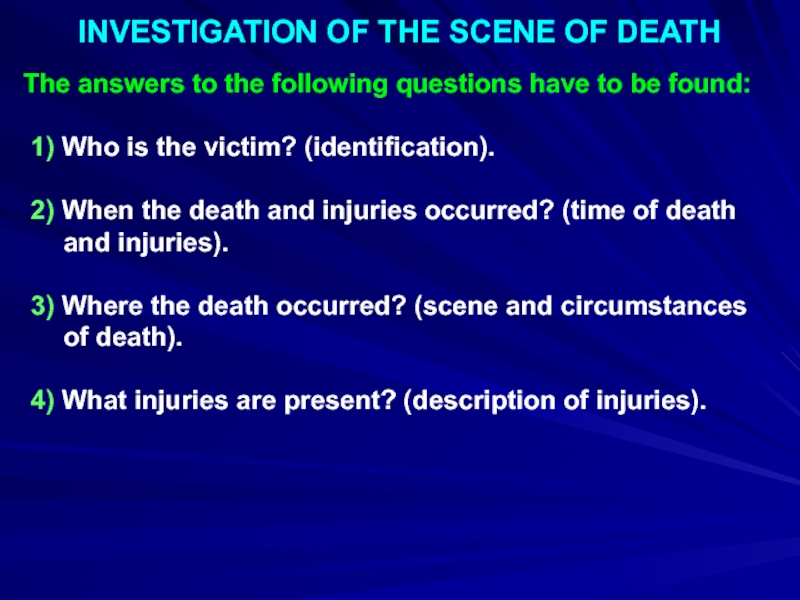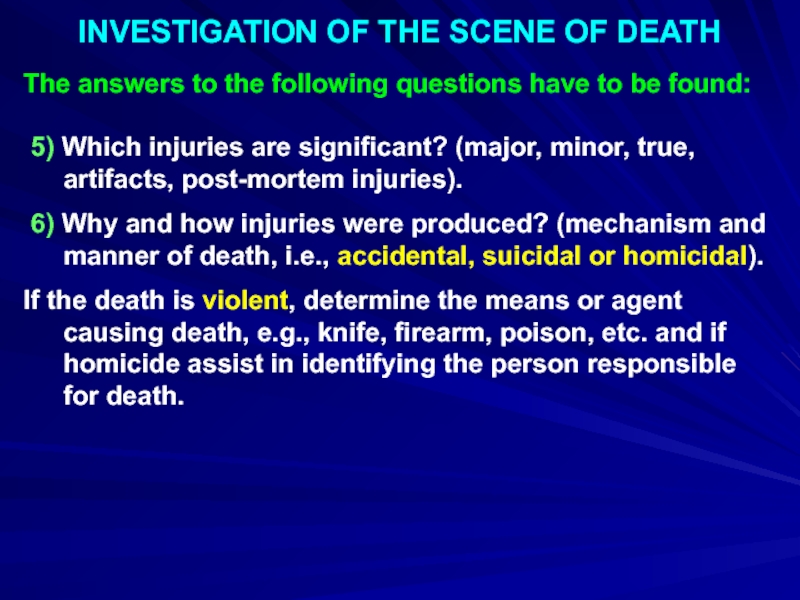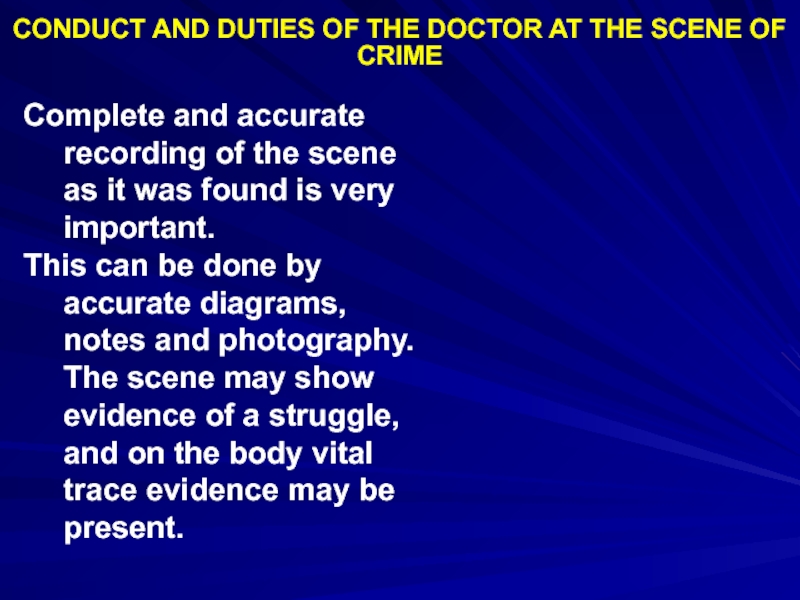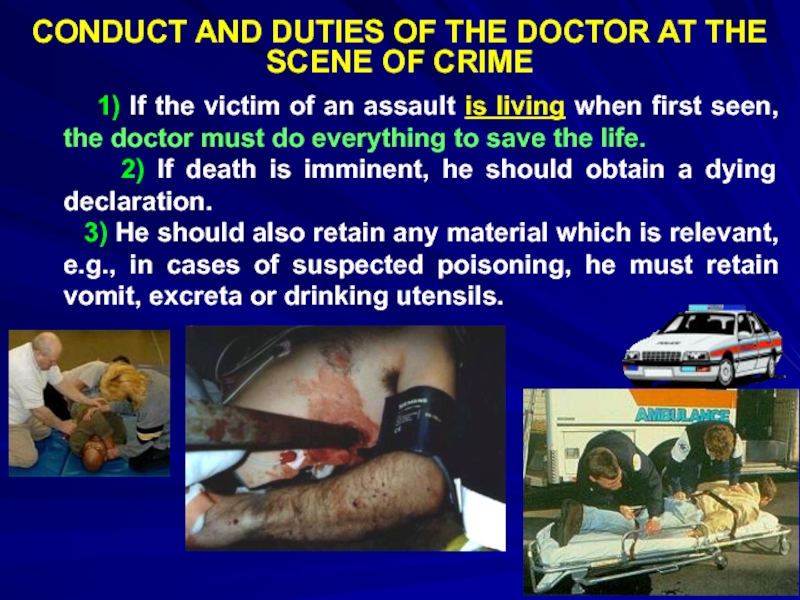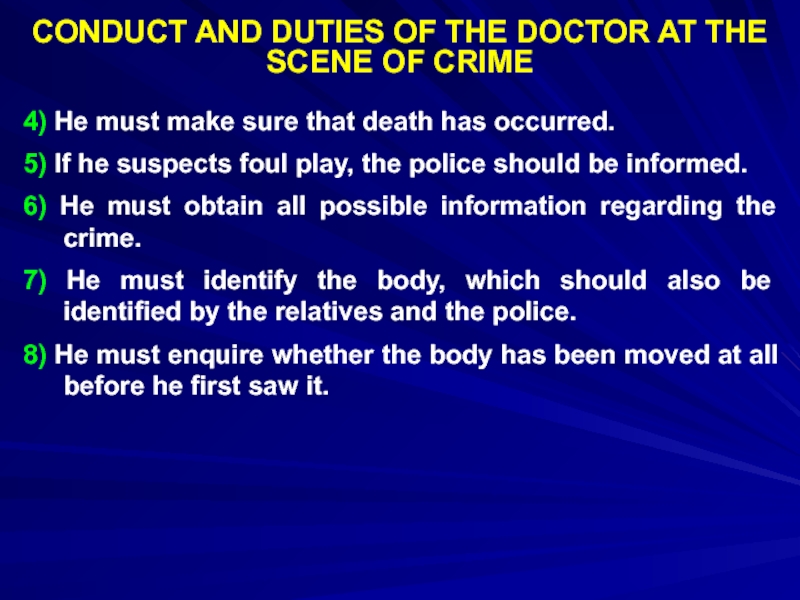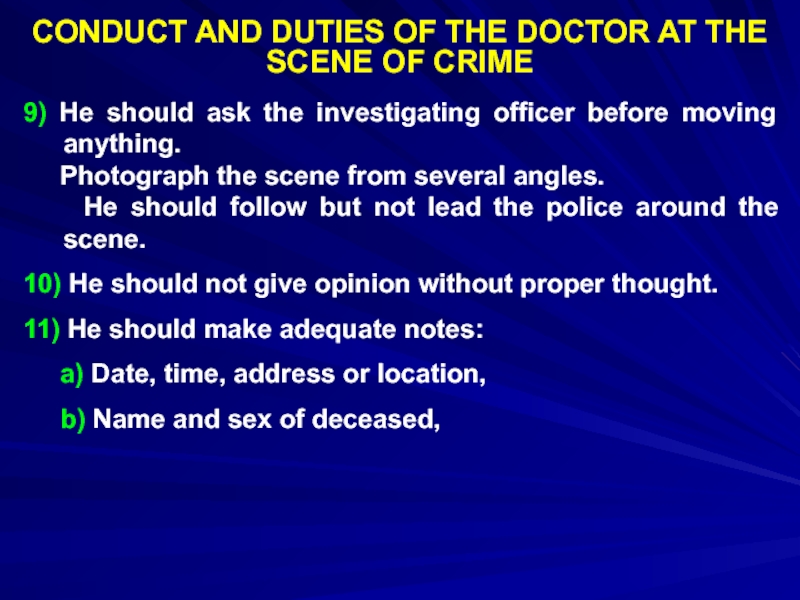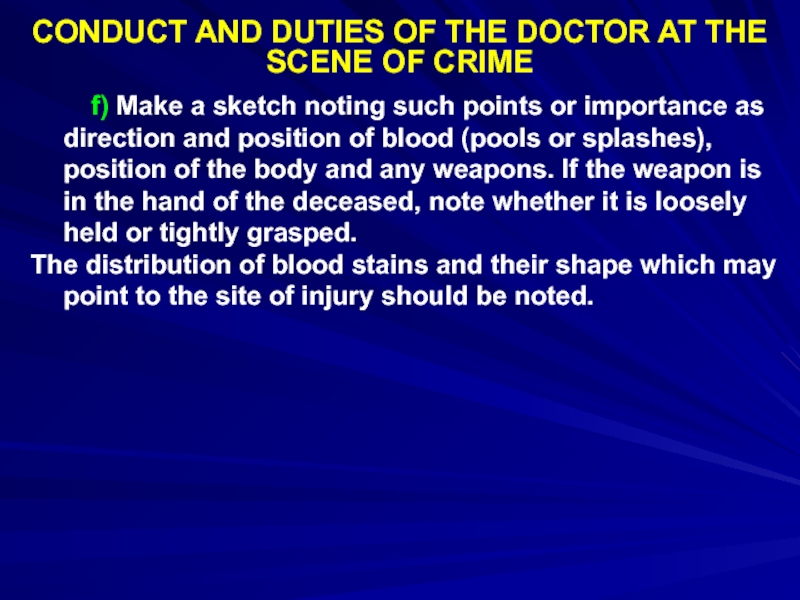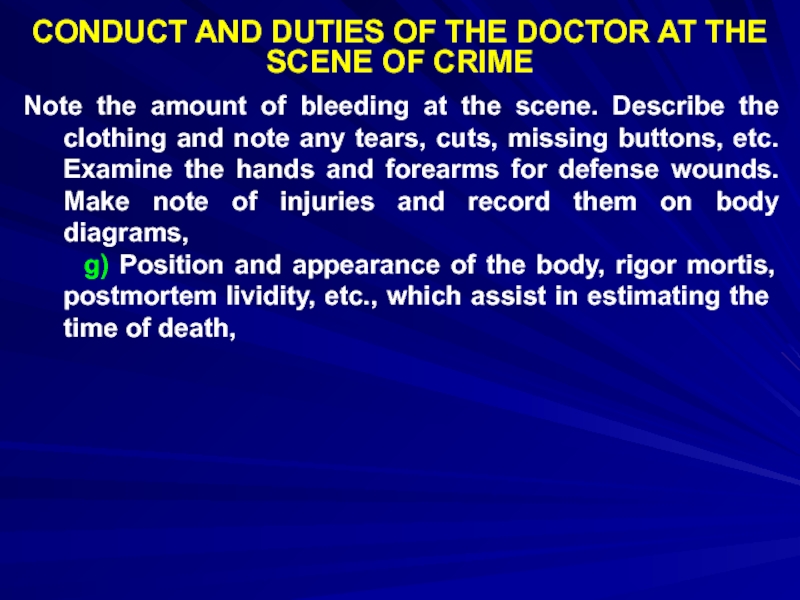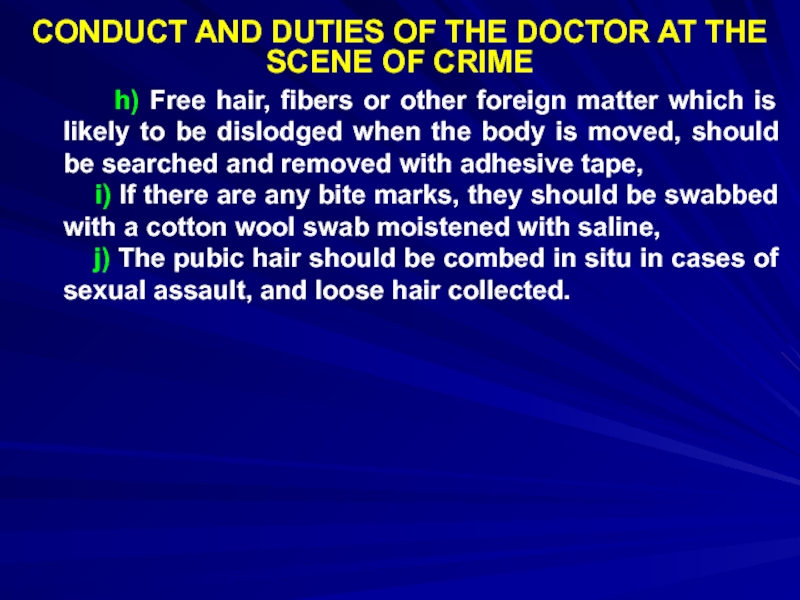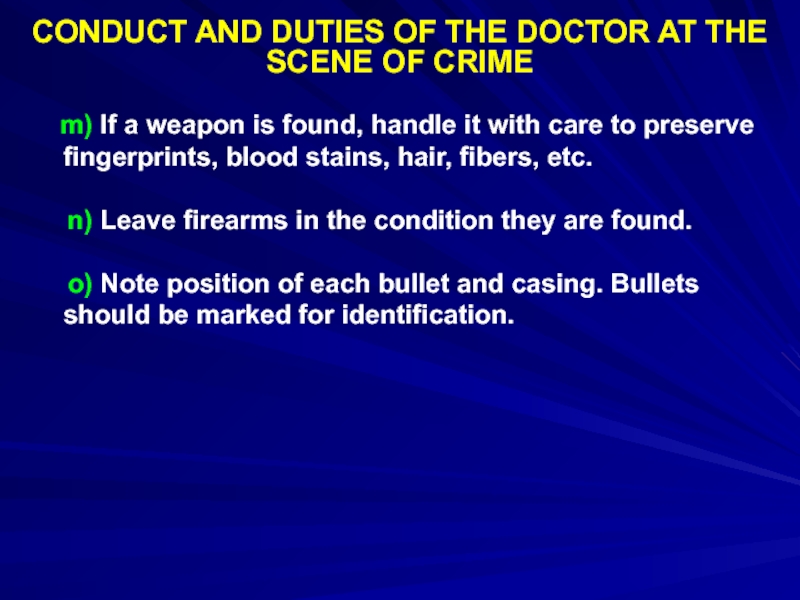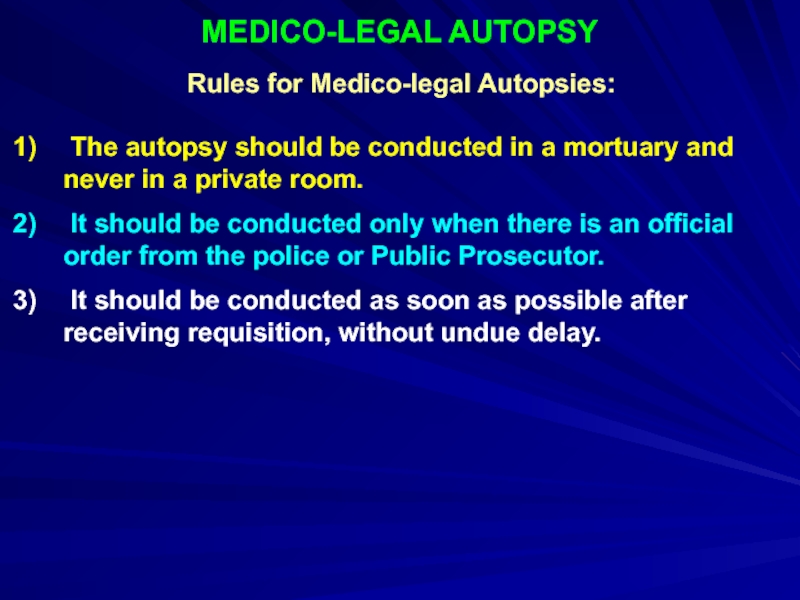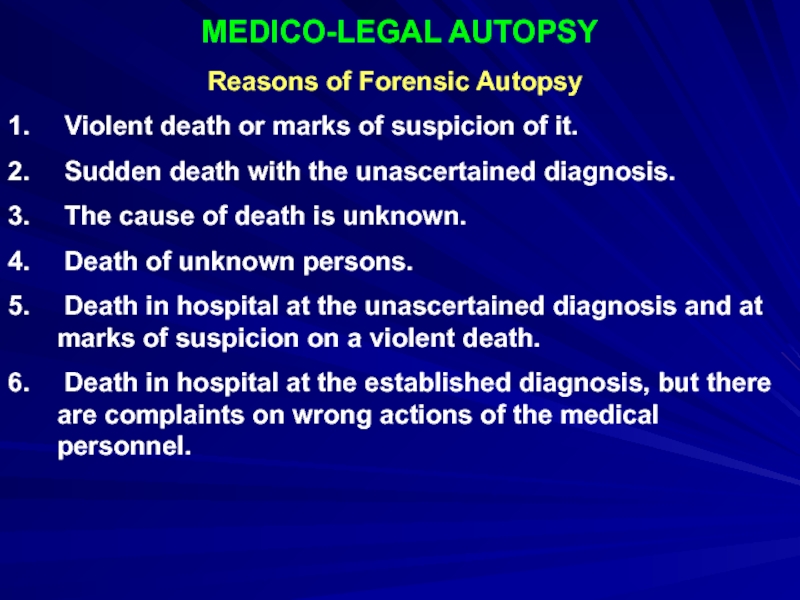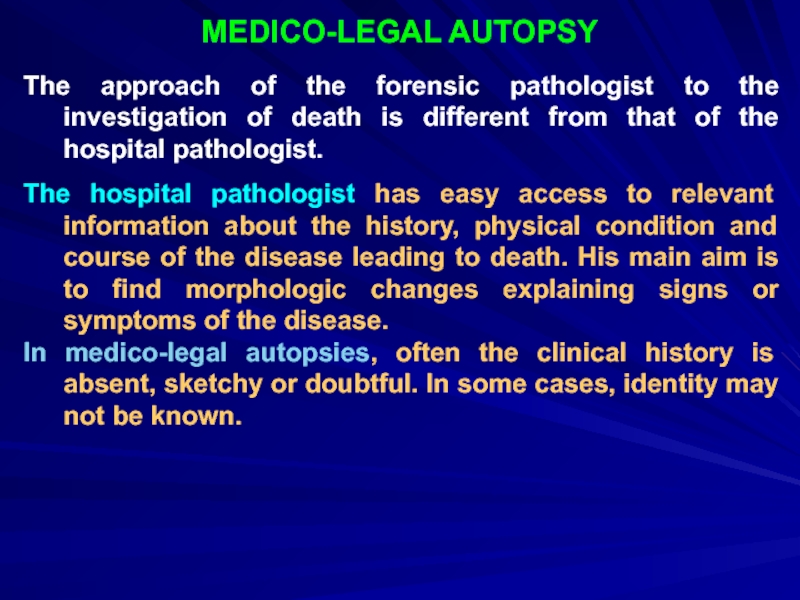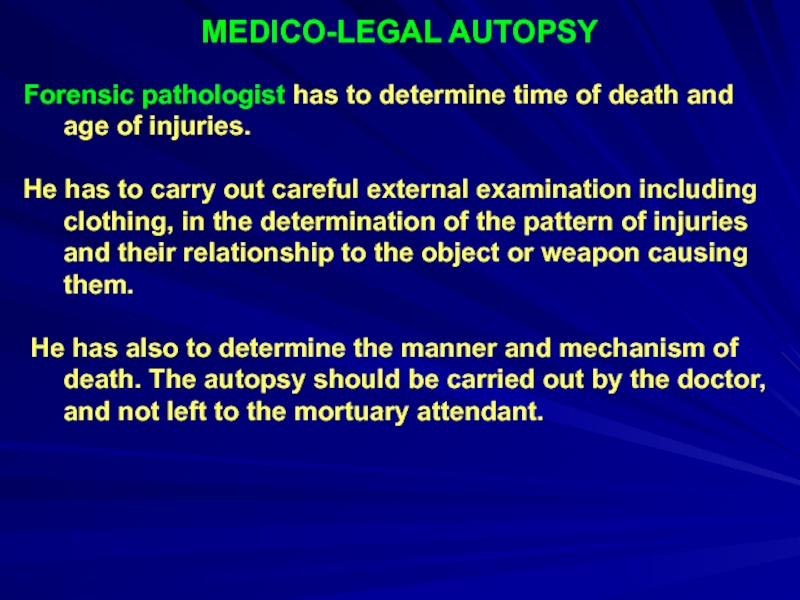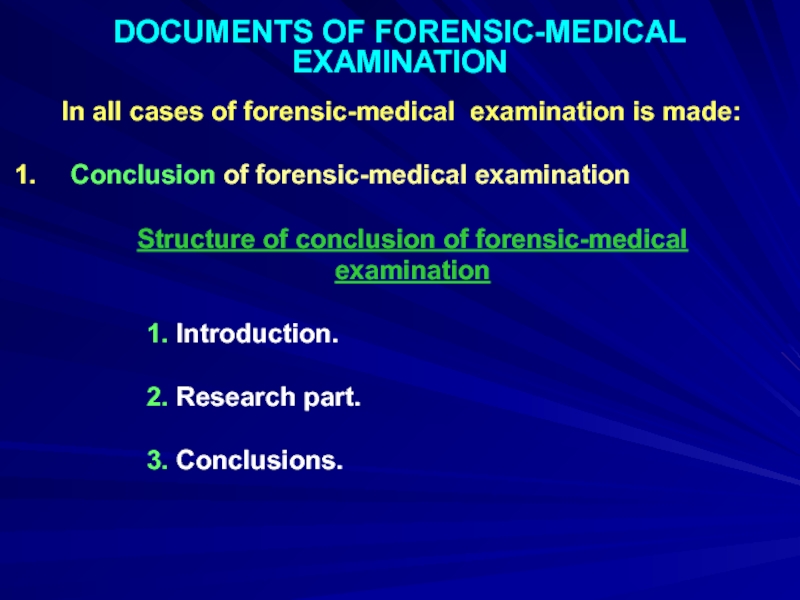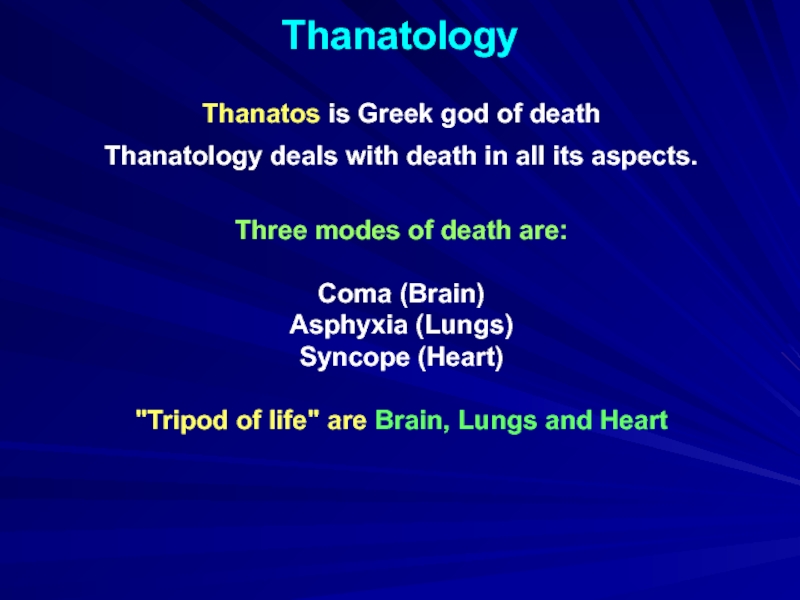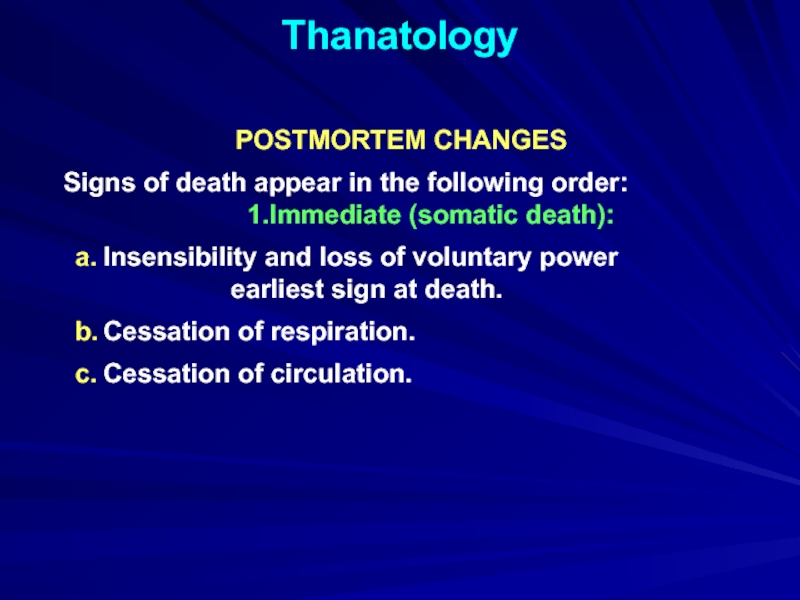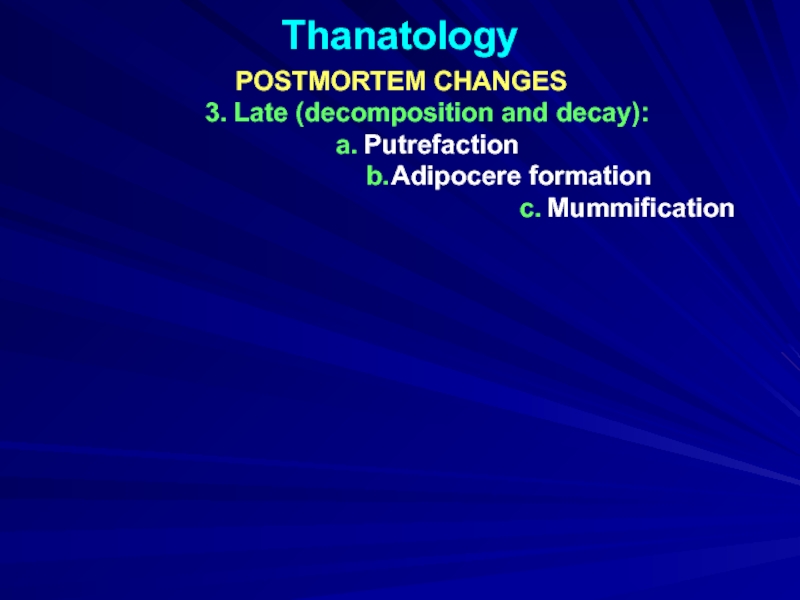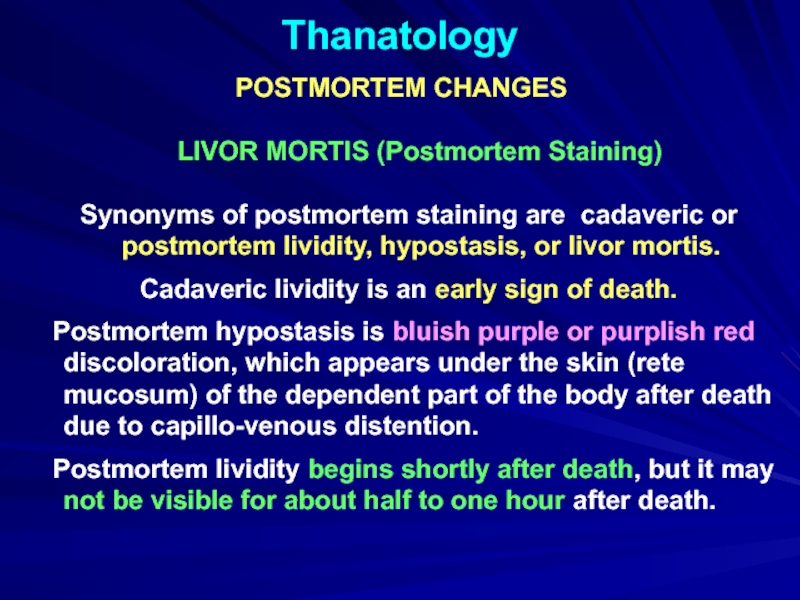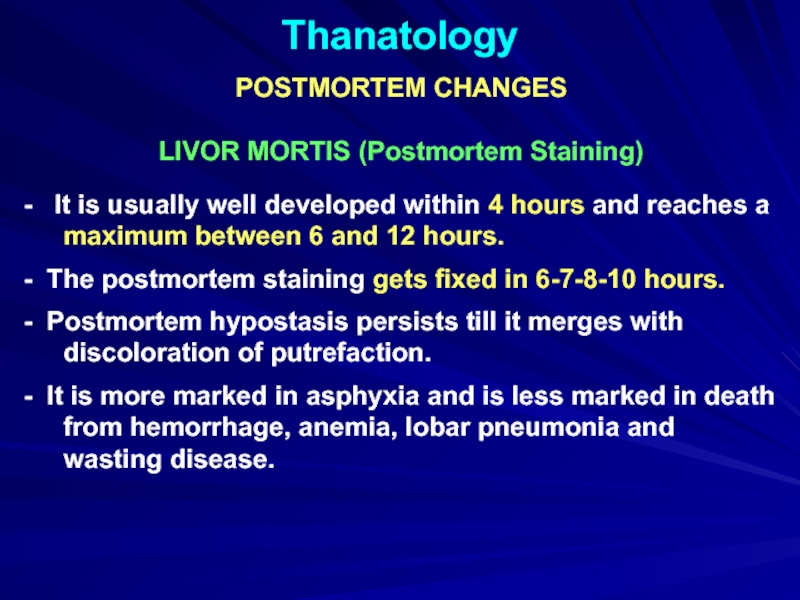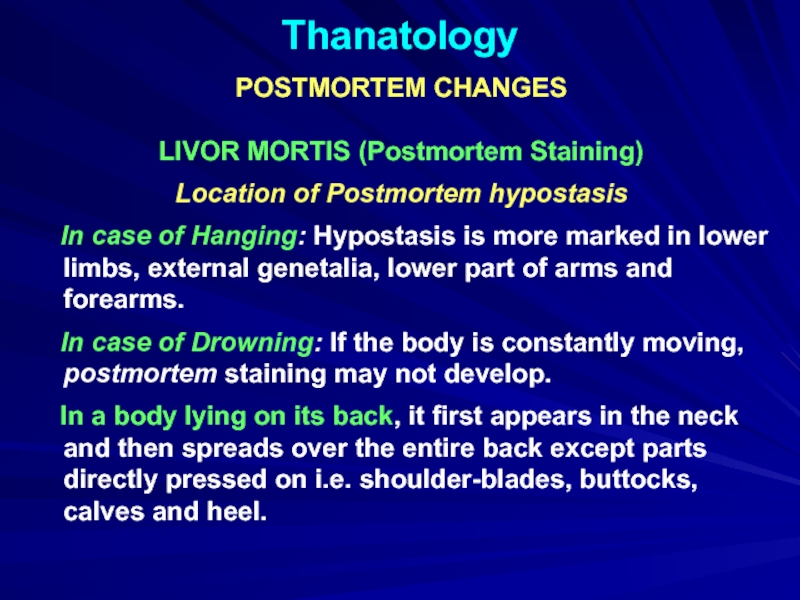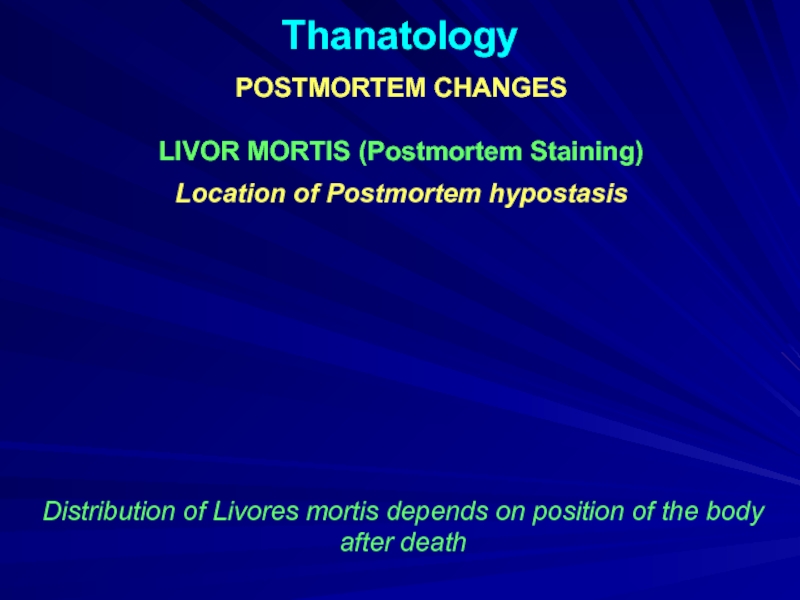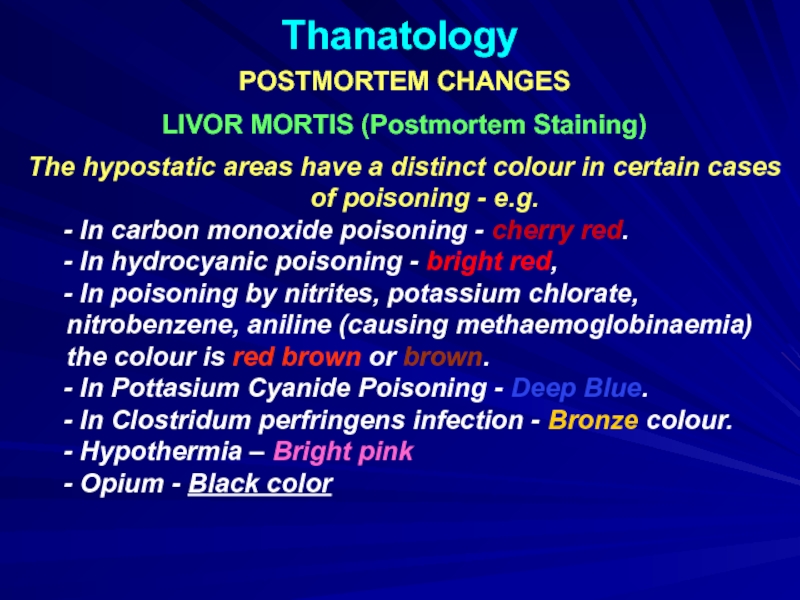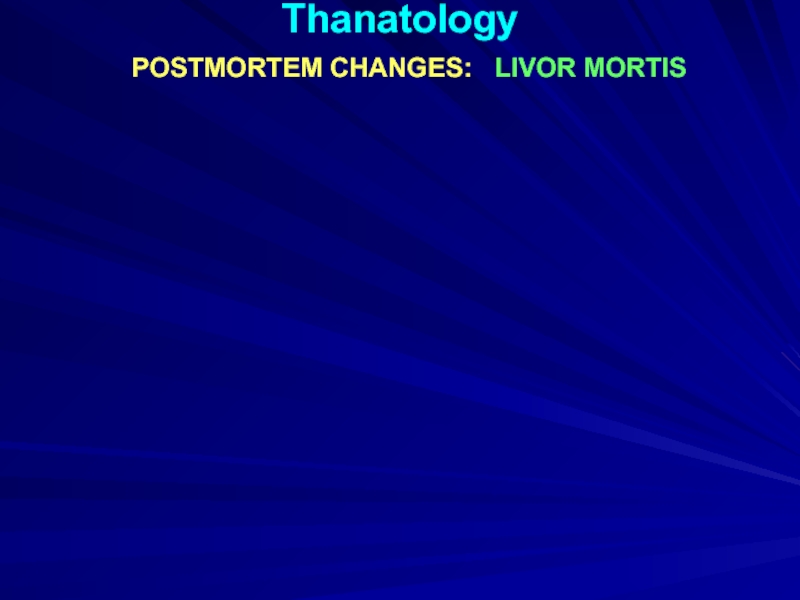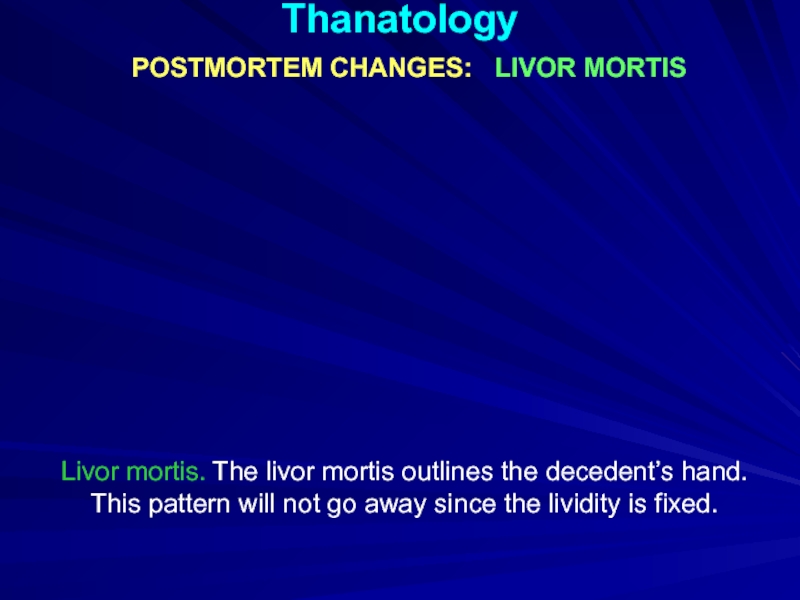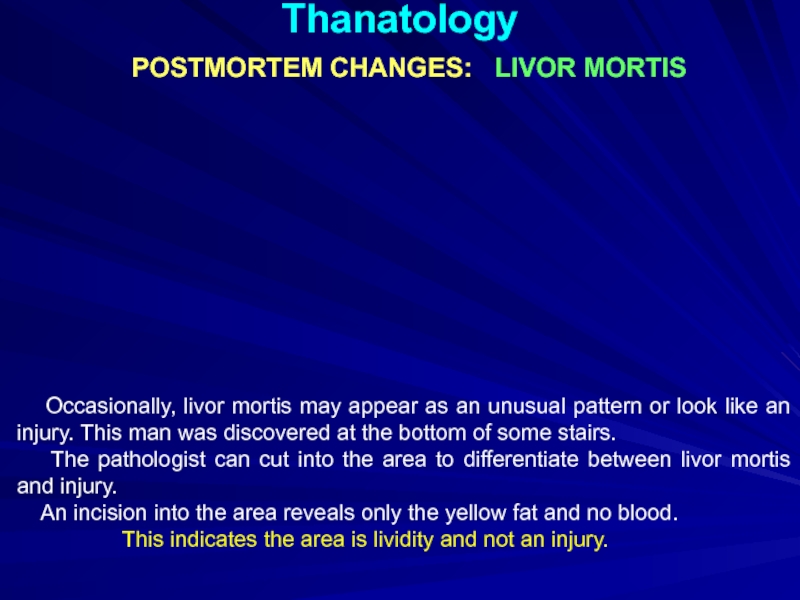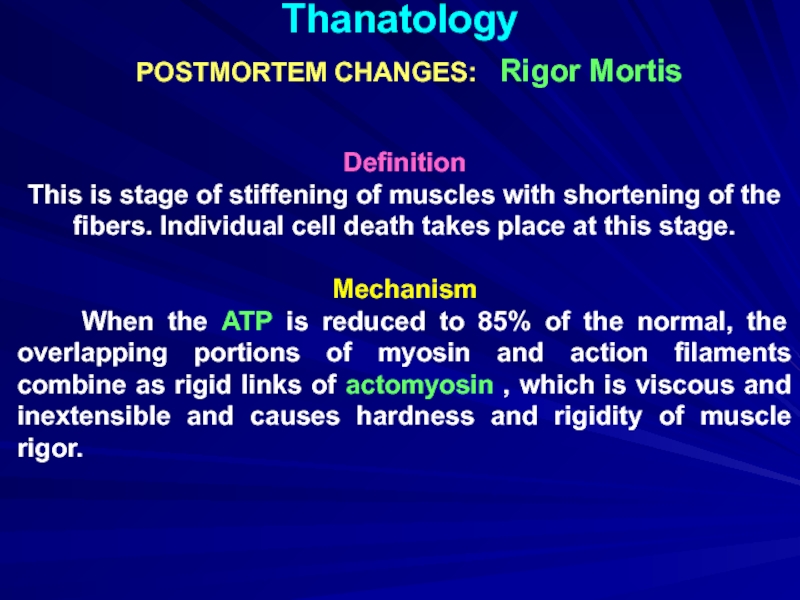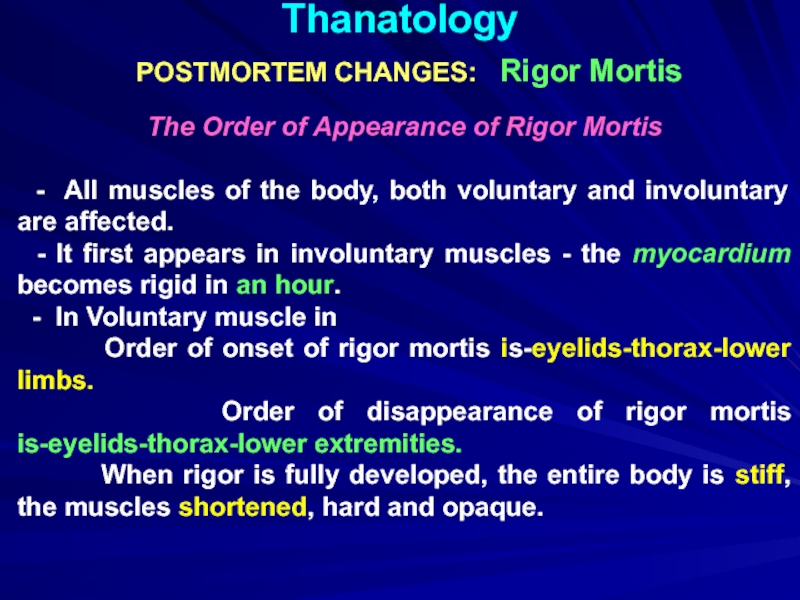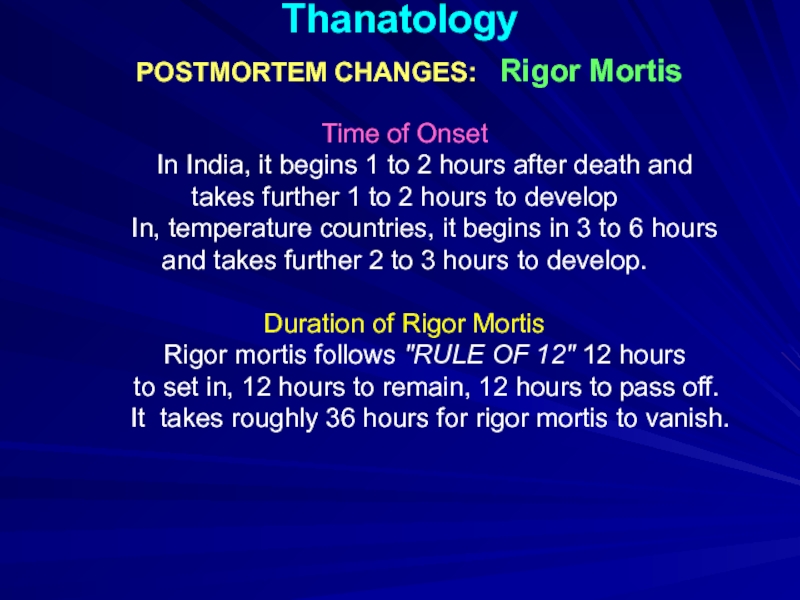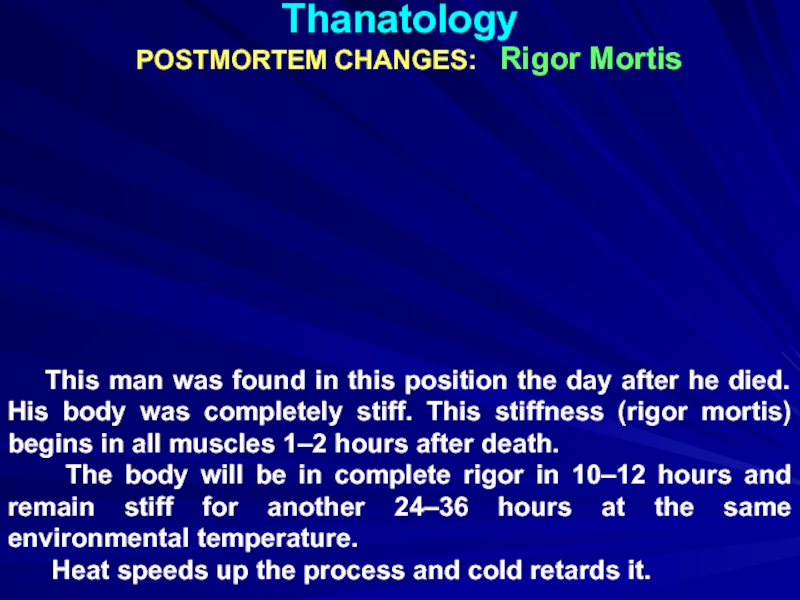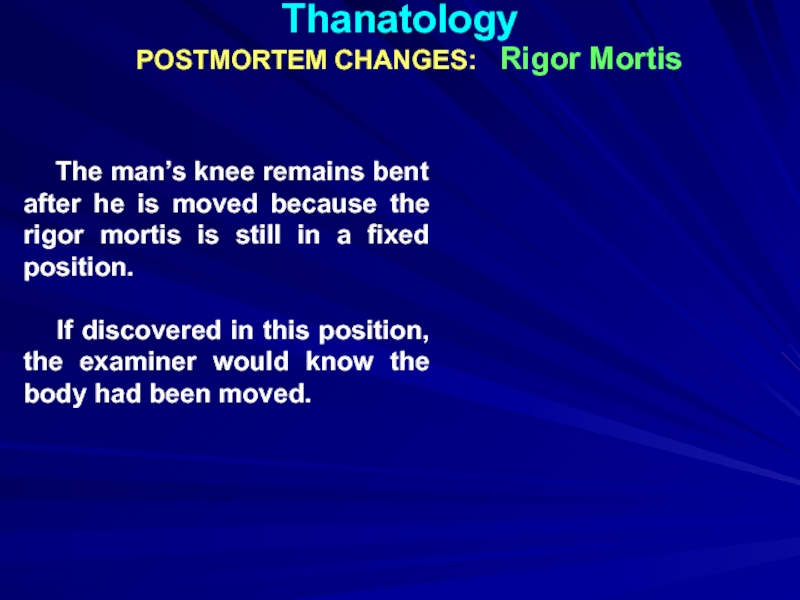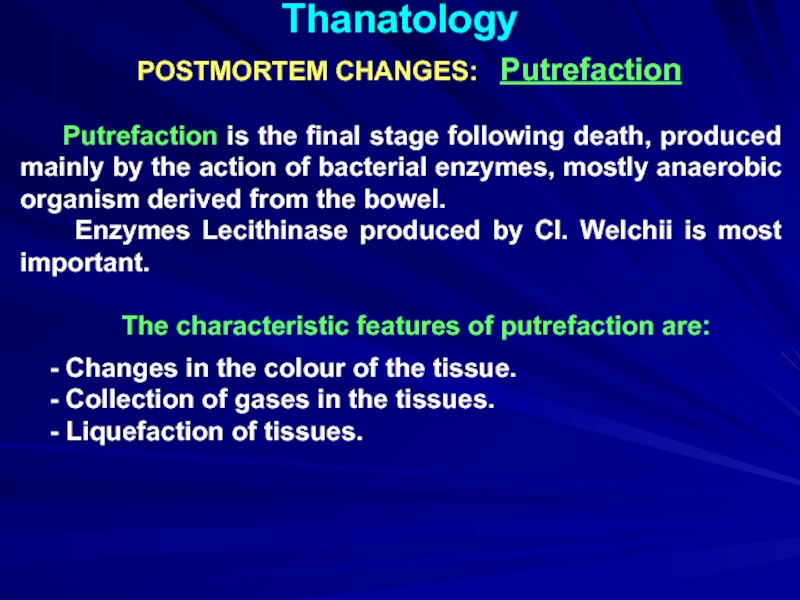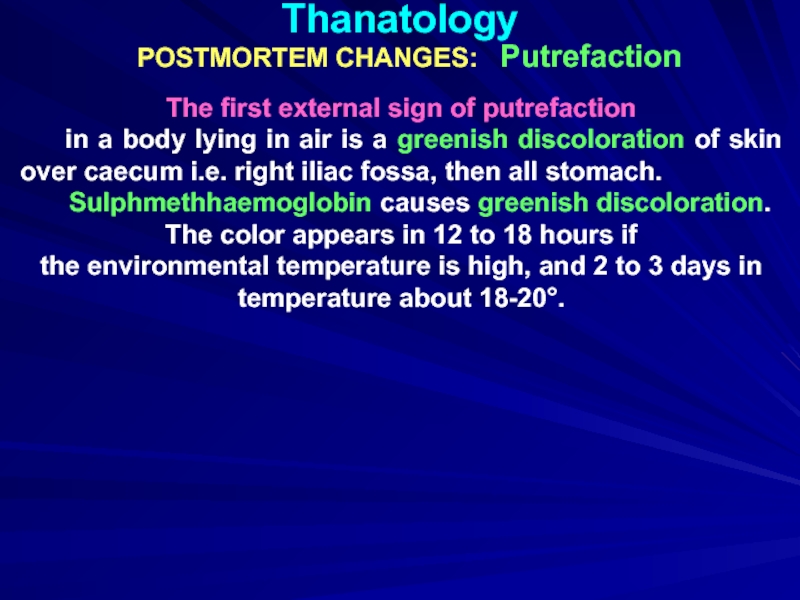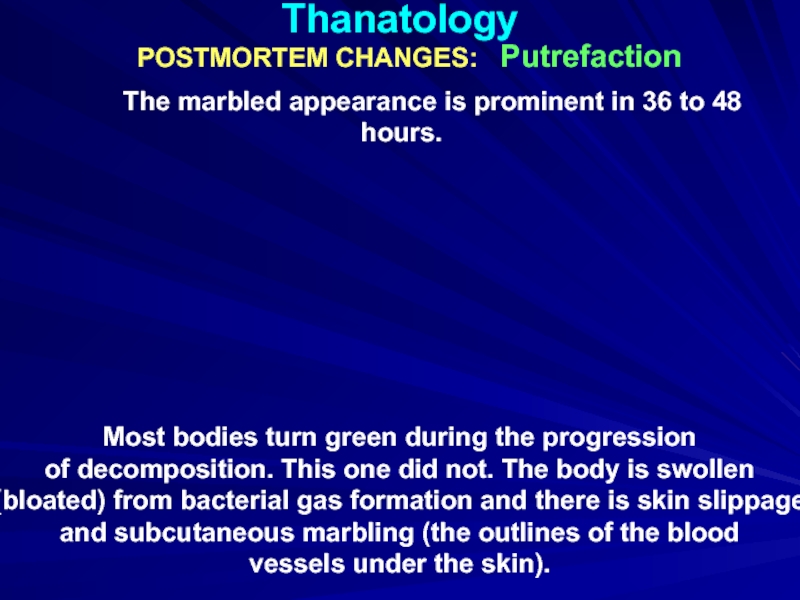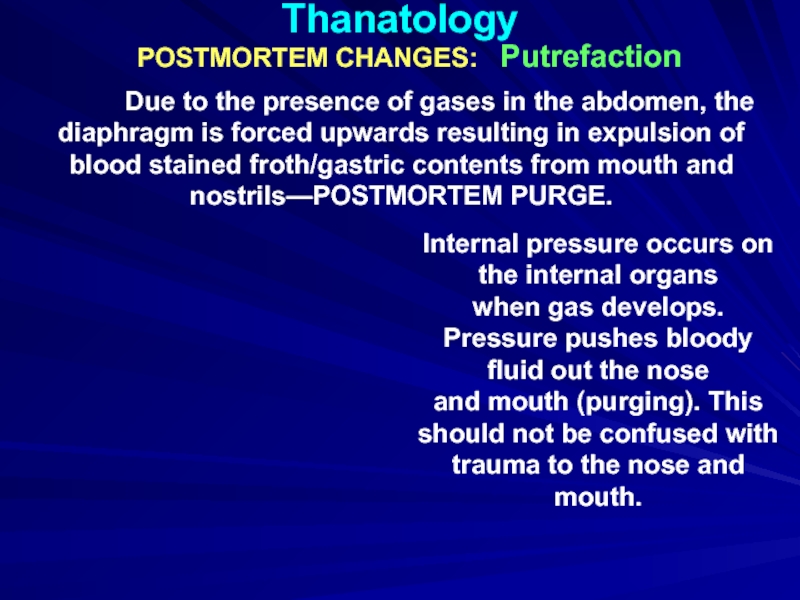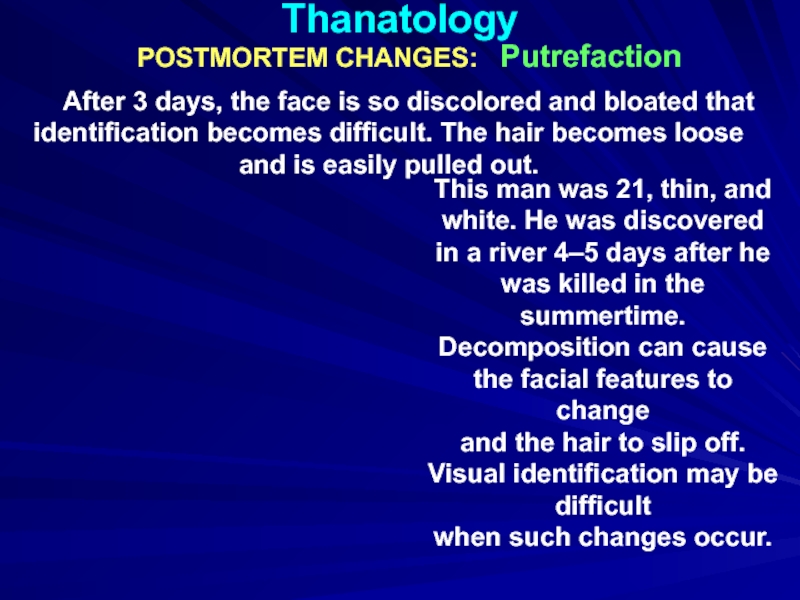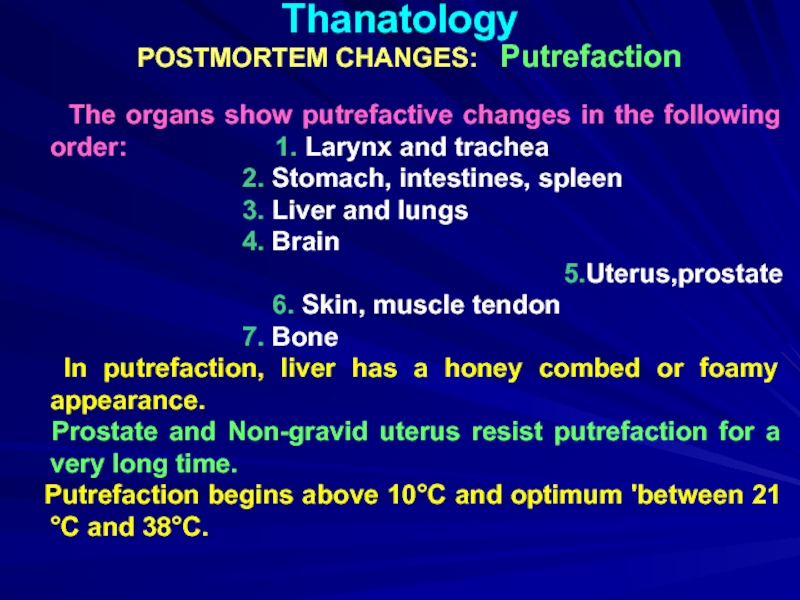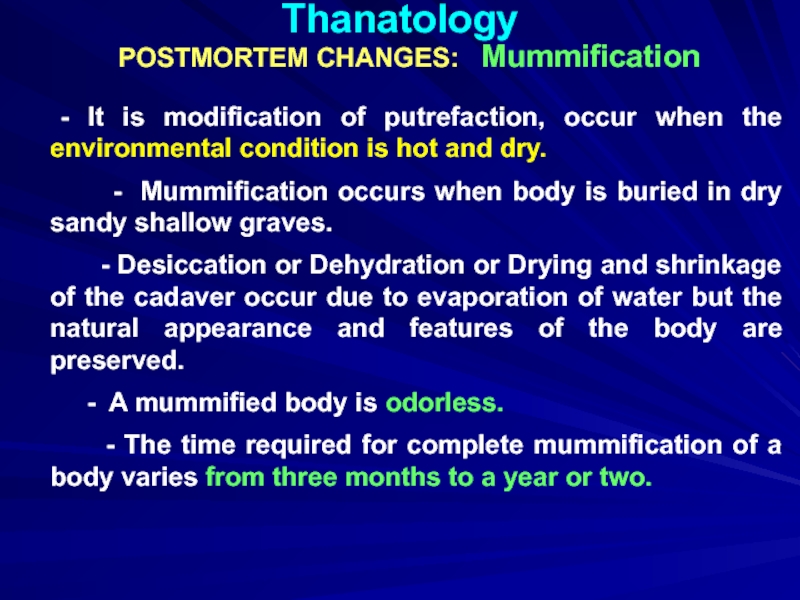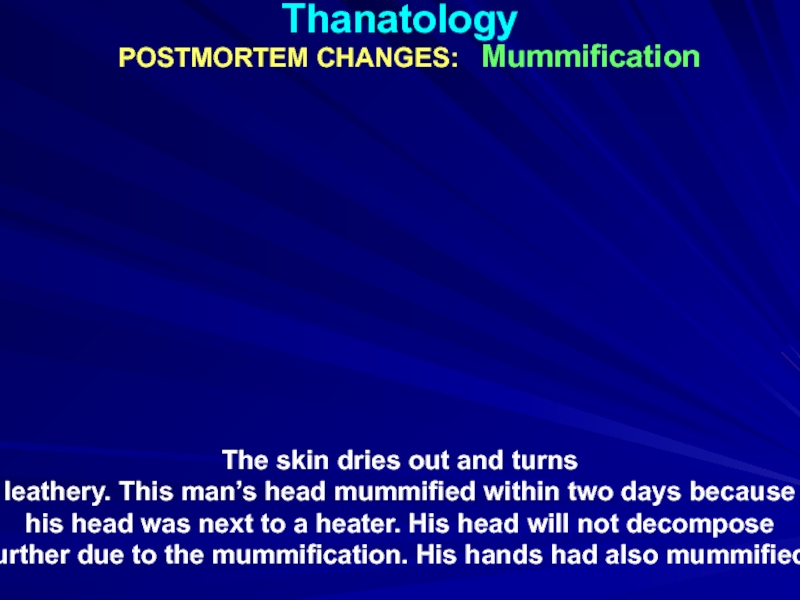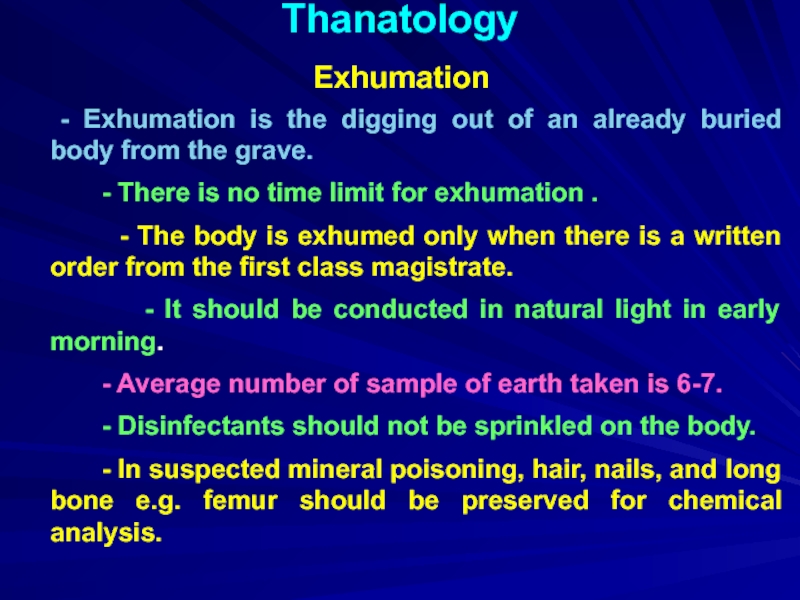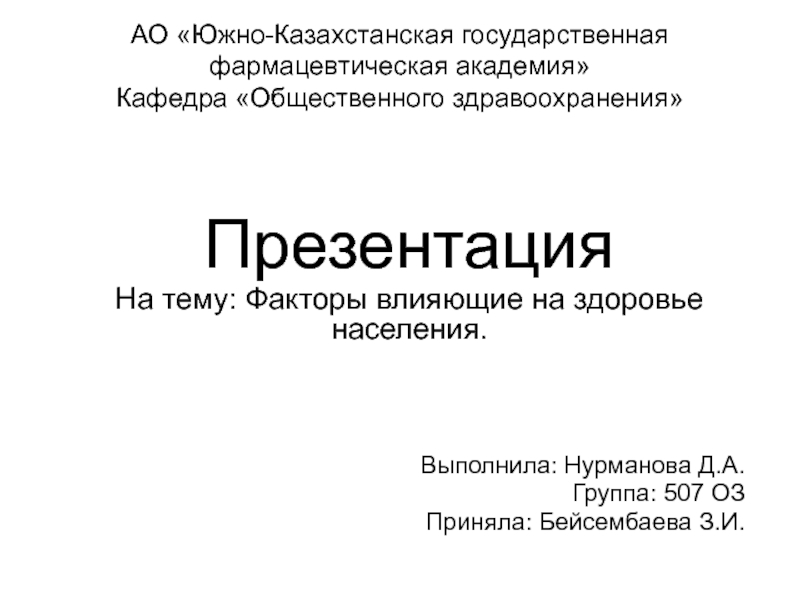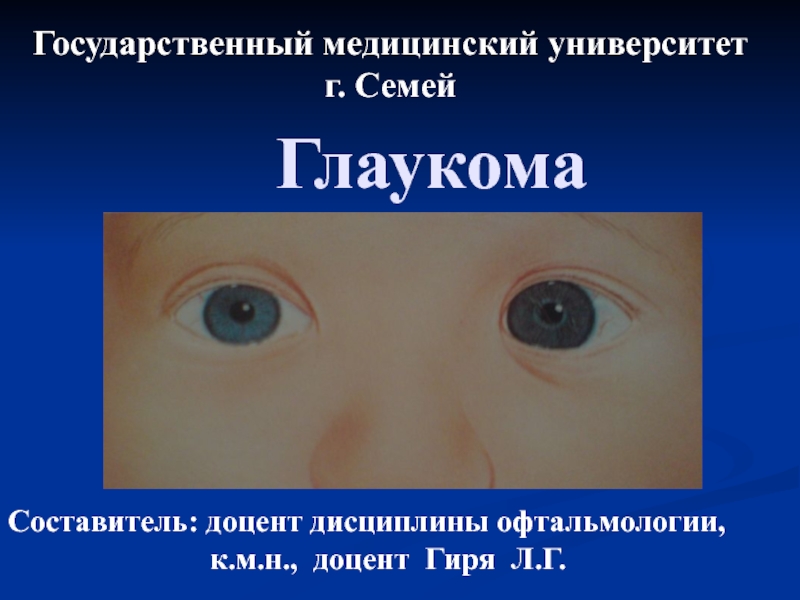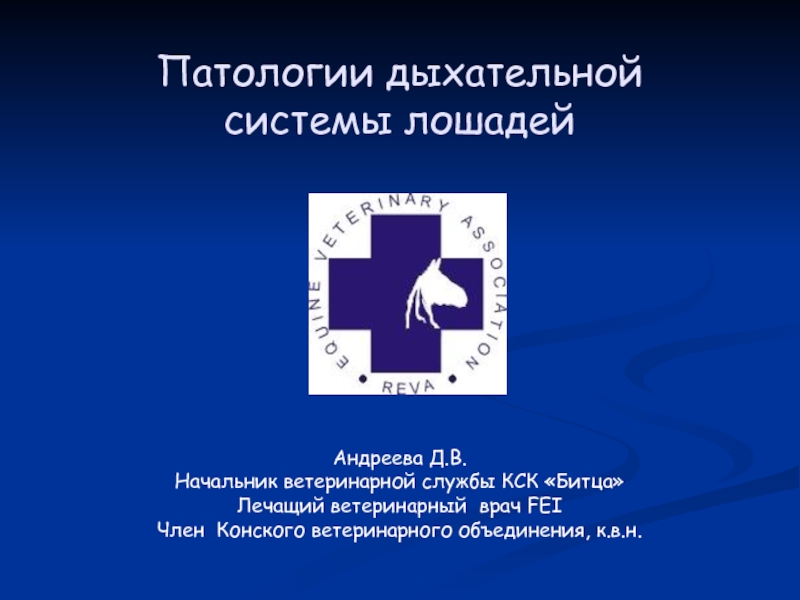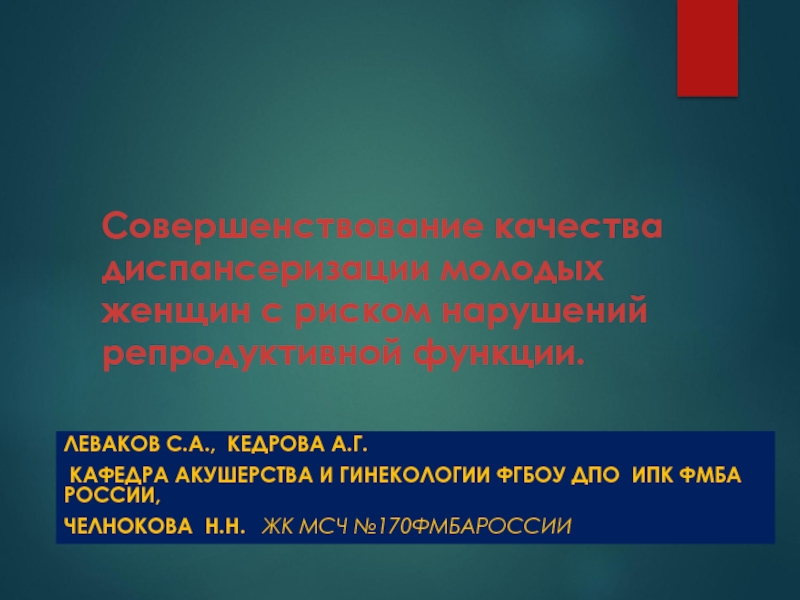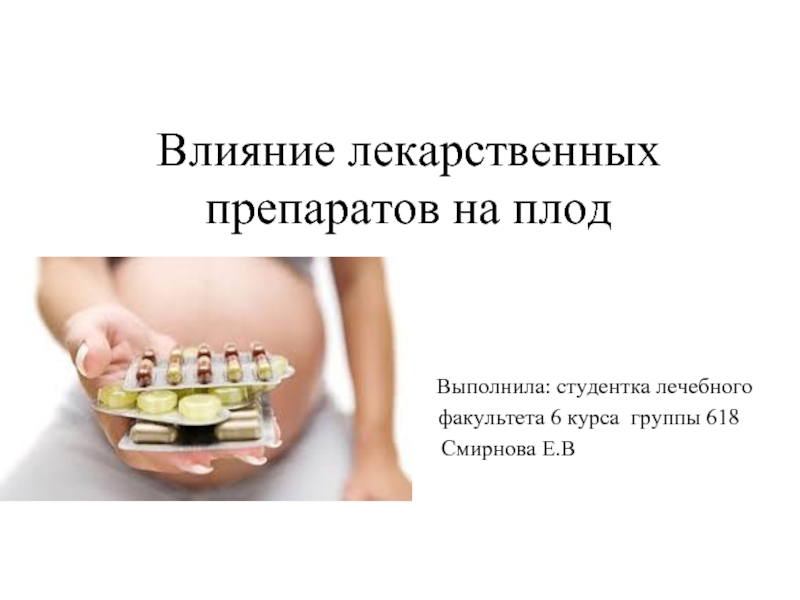GENERAL QUESTIONS OF FORENSIC MEDICINE
- Главная
- Разное
- Дизайн
- Бизнес и предпринимательство
- Аналитика
- Образование
- Развлечения
- Красота и здоровье
- Финансы
- Государство
- Путешествия
- Спорт
- Недвижимость
- Армия
- Графика
- Культурология
- Еда и кулинария
- Лингвистика
- Английский язык
- Астрономия
- Алгебра
- Биология
- География
- Детские презентации
- Информатика
- История
- Литература
- Маркетинг
- Математика
- Медицина
- Менеджмент
- Музыка
- МХК
- Немецкий язык
- ОБЖ
- Обществознание
- Окружающий мир
- Педагогика
- Русский язык
- Технология
- Физика
- Философия
- Химия
- Шаблоны, картинки для презентаций
- Экология
- Экономика
- Юриспруденция
Forensic or legal medicine презентация
Содержание
- 1. Forensic or legal medicine
- 2. FORENSIC OR LEGAL MEDICINE Forensic or legal
- 3. FORENSIC MEDICINE Forensic medicine deals almost entirely
- 4. FORENSIC MEDICINE Its particular field of activity
- 5. The medical expert should be very careful
- 6. Three things are needed for success:
- 7. Forensic medicine is not an exact science.
- 8. The doctor should be ready to defend
- 9. For the purpose of illustrating and clarifying
- 10. Forensic-medical examination is performed only when there
- 11. Objects of forensic-medical examination: 3. Material
- 12. Examination or research of these objects is
- 13. INVESTIGATION OF THE SCENE OF DEATH
- 14. INVESTIGATION OF THE SCENE OF DEATH
- 15. INVESTIGATION OF THE SCENE OF DEATH
- 16. INVESTIGATION OF THE SCENE OF DEATH
- 17. INVESTIGATION OF THE SCENE OF DEATH
- 18. INVESTIGATION OF THE SCENE OF DEATH
- 19. INVESTIGATION OF THE SCENE OF DEATH
- 20. CONDUCT AND DUTIES OF THE DOCTOR AT
- 21. CONDUCT AND DUTIES OF THE DOCTOR AT
- 22. CONDUCT AND DUTIES OF THE DOCTOR AT
- 23. CONDUCT AND DUTIES OF THE DOCTOR AT
- 24. CONDUCT AND DUTIES OF THE DOCTOR AT
- 25. CONDUCT AND DUTIES OF THE DOCTOR AT
- 26. CONDUCT AND DUTIES OF THE DOCTOR AT
- 27. CONDUCT AND DUTIES OF THE DOCTOR AT
- 28. CONDUCT AND DUTIES OF THE DOCTOR AT
- 29. CONDUCT AND DUTIES OF THE DOCTOR AT
- 30. MEDICO-LEGAL AUTOPSY Objects:
- 31. MEDICO-LEGAL AUTOPSY Rules for Medico-legal
- 32. MEDICO-LEGAL AUTOPSY Reasons of Forensic
- 33. MEDICO-LEGAL AUTOPSY The approach of
- 34. MEDICO-LEGAL AUTOPSY Forensic pathologist
- 35. DOCUMENTS OF FORENSIC-MEDICAL EXAMINATION
- 36. Thanatology Thanatos is Greek
- 37. Thanatology POSTMORTEM CHANGES Signs
- 38. Thanatology POSTMORTEM CHANGES
- 39. Thanatology POSTMORTEM CHANGES
- 40. Thanatology POSTMORTEM CHANGES
- 41. Thanatology POSTMORTEM CHANGES
- 42. Thanatology POSTMORTEM CHANGES
- 43. Thanatology POSTMORTEM CHANGES
- 44. Thanatology POSTMORTEM CHANGES
- 45. Thanatology POSTMORTEM CHANGES: LIVOR MORTIS
- 46. Thanatology POSTMORTEM CHANGES:
- 47. Thanatology POSTMORTEM CHANGES:
- 48. Thanatology POSTMORTEM CHANGES:
- 49. Thanatology POSTMORTEM CHANGES:
- 50. Thanatology POSTMORTEM CHANGES:
- 51. Thanatology POSTMORTEM CHANGES:
- 52. Thanatology POSTMORTEM CHANGES:
- 53. Thanatology POSTMORTEM
- 54. Thanatology POSTMORTEM
- 55. Thanatology POSTMORTEM
- 56. Thanatology POSTMORTEM
- 57. Thanatology POSTMORTEM
- 58. Thanatology POSTMORTEM
- 59. Thanatology POSTMORTEM
- 60. Thanatology POSTMORTEM
- 61. Thanatology Exhumation
Слайд 1
ZAPOROZHIAL STATE MEDICAL UNIVERSITY
THE DEPARTMENT OF PATHOLOGICAL ANATOMY and FORENSIC MEDICINE
lecture
Слайд 2FORENSIC OR LEGAL MEDICINE
Forensic or legal medicine deals with the application
knowledge to aid in the administration of justice. It is used by the
legal authorities for the solution of legal problems.
Some examples are: applying the medical knowledge in deciding
cases of injuries, asphyxias deaths, sexual offences,
infant deaths, poisoning, etc. In short it deals with medical
aspects of law.
Слайд 3FORENSIC MEDICINE
Forensic medicine deals almost entirely with crimes against the person,
Its aim is to find out the truth.
Слайд 4FORENSIC MEDICINE
Its particular field of activity is judicial investigation, both civil
In all cases of crime involving the person, e.g. homicide, suicide, assault, sexual offences, traffic accidents, poisoning, etc., the help of the medical practitioner is sought by the police. In all such cases, the doctor will be required to appear as an expert witness in a Court of law.
Слайд 5The medical expert should be very careful when he is examining
He should not encourage an accused person to talk about the crime with which he is charged, or about the events that led to his arrest.
If, during a medical examination, a person says anything that might incriminate himself, it should be neither recorded not repeated.
FORENSIC MEDICINE
Слайд 6Three things are needed for success:
the power of observation,
2)
3) the power of deduction.
A good command of language, clear presentation, and ability in expressing a relatively firm opinion are necessary for the success of the forensic pathologist.
The forensic pathologist must be alert to where evidence should be looked for, and how it should be interpreted.
FORENSIC MEDICINE
Слайд 7Forensic medicine is not an exact science. Unexpected results are produced
In every case, there is an element of uncertainty, and absolute proof is a rarity in any medical problem.
Doctors should bear in mind the essential difference between probability and proof.
The medical witness should not be dogmatic about his opinion.
FORENSIC MEDICINE
Слайд 8The doctor should be ready to defend every finding and conclusion
He should be aware of professional and scientific viewpoints which might differ from his, and should be familiar with the latest scientific literature in relation to the subject involved.
FORENSIC MEDICINE
Слайд 9For the purpose of illustrating and clarifying his testimony, the medical
FORENSIC MEDICINE
Слайд 10Forensic-medical examination is performed only when there is a written resolution
Objects of forensic-medical examination:
Dead body.
2. Living person (a victim , is suspected and other persons).
FORENSIC-MEDICINE EXAMINATION
Слайд 11Objects of forensic-medical examination:
3. Material evidences.
4. Materials of crime cases.
FORENSIC-MEDICINE
Слайд 12Examination or research of these objects is produced in Bureau of
1. Forensic-medical mortuary (morgue).
2. Department for examination of victims, suspected and other living persons.
3. Forensic-medical laboratories ( histological immunological, cytological, chemical, criminalisticals).
FORENSIC-MEDICINE EXAMINATION
Слайд 13INVESTIGATION OF THE SCENE OF DEATH
The first research of dead
The basic rules for investigation of any scene of crime are:
1) verify that a crime has been committed,
2) look for signs of how it was committed,
3) recover and preserve evidence that might lead to the arrest and conviction of the guilty.
Слайд 14INVESTIGATION OF THE SCENE OF DEATH
Medico-legal Masquerades:
Many cases of
Слайд 15INVESTIGATION OF THE SCENE OF DEATH
Accidental deaths and suicides can
In a suicide case, alterations may be made at the scene because of stigma. In a homicide case, the scene may be altered or rigged to suggest that death resulted from suicide or accident.
Слайд 16INVESTIGATION OF THE SCENE OF DEATH
The doctor must look for
Слайд 17INVESTIGATION OF THE SCENE OF DEATH
In such cases, the real
The investigating officer should obtain information about the circumstances of death and the background of the deceased.
Слайд 18INVESTIGATION OF THE SCENE OF DEATH
The answers to the following
1) Who is the victim? (identification).
2) When the death and injuries occurred? (time of death and injuries).
3) Where the death occurred? (scene and circumstances of death).
4) What injuries are present? (description of injuries).
Слайд 19INVESTIGATION OF THE SCENE OF DEATH
The answers to the following
5) Which injuries are significant? (major, minor, true, artifacts, post-mortem injuries).
6) Why and how injuries were produced? (mechanism and manner of death, i.e., accidental, suicidal or homicidal).
If the death is violent, determine the means or agent causing death, e.g., knife, firearm, poison, etc. and if homicide assist in identifying the person responsible for death.
Слайд 20CONDUCT AND DUTIES OF THE DOCTOR AT THE SCENE OF CRIME
Complete
This can be done by accurate diagrams, notes and photography. The scene may show evidence of a struggle, and on the body vital trace evidence may be present.
Слайд 21CONDUCT AND DUTIES OF THE DOCTOR AT THE SCENE OF CRIME
2) If death is imminent, he should obtain a dying declaration.
3) He should also retain any material which is relevant, e.g., in cases of suspected poisoning, he must retain vomit, excreta or drinking utensils.
Слайд 22CONDUCT AND DUTIES OF THE DOCTOR AT THE SCENE OF CRIME
4)
5) If he suspects foul play, the police should be informed.
6) He must obtain all possible information regarding the crime.
7) He must identify the body, which should also be identified by the relatives and the police.
8) He must enquire whether the body has been moved at all before he first saw it.
Слайд 23CONDUCT AND DUTIES OF THE DOCTOR AT THE SCENE OF CRIME
9)
Photograph the scene from several angles.
He should follow but not lead the police around the scene.
10) He should not give opinion without proper thought.
11) He should make adequate notes:
a) Date, time, address or location,
b) Name and sex of deceased,
Слайд 24CONDUCT AND DUTIES OF THE DOCTOR AT THE SCENE OF CRIME
d) General observation about the scene; any evidence of struggle, such as overturned furniture or trampled ground. Note surroundings of the body, such as walls, flooring, fixtures, furniture, doors and windows.
e) Temperature of the surroundings, and the rectal temperature of the deceased should be taken,
Слайд 25CONDUCT AND DUTIES OF THE DOCTOR AT THE SCENE OF CRIME
The distribution of blood stains and their shape which may point to the site of injury should be noted.
Слайд 26CONDUCT AND DUTIES OF THE DOCTOR AT THE SCENE OF CRIME
Note
g) Position and appearance of the body, rigor mortis, postmortem lividity, etc., which assist in estimating the time of death,
Слайд 27CONDUCT AND DUTIES OF THE DOCTOR AT THE SCENE OF CRIME
i) If there are any bite marks, they should be swabbed with a cotton wool swab moistened with saline,
j) The pubic hair should be combed in situ in cases of sexual assault, and loose hair collected.
Слайд 28CONDUCT AND DUTIES OF THE DOCTOR AT THE SCENE OF CRIME
l) Photograph any ligature before removal, cut if necessary leaving the knot or knots intact.
Слайд 29CONDUCT AND DUTIES OF THE DOCTOR AT THE SCENE OF CRIME
n) Leave firearms in the condition they are found.
o) Note position of each bullet and casing. Bullets should be marked for identification.
Слайд 30MEDICO-LEGAL AUTOPSY
Objects:
To find out the cause of death,
2) To find out the manner of death, whether accidental, suicidal or homicidal.
3) To find out the time since death.
4) To establish identity when not known.
5) To collect evidence in order to identify the object causing death and to identify the criminal.
6) In newborn infants to determine the question of live birth and viability.
Слайд 31MEDICO-LEGAL AUTOPSY
Rules for Medico-legal Autopsies:
The autopsy should be
It should be conducted only when there is an official order from the police or Public Prosecutor.
It should be conducted as soon as possible after receiving requisition, without undue delay.
Слайд 32MEDICO-LEGAL AUTOPSY
Reasons of Forensic Autopsy
Violent death or marks of
Sudden death with the unascertained diagnosis.
The cause of death is unknown.
Death of unknown persons.
Death in hospital at the unascertained diagnosis and at marks of suspicion on a violent death.
Death in hospital at the established diagnosis, but there are complaints on wrong actions of the medical personnel.
Слайд 33MEDICO-LEGAL AUTOPSY
The approach of the forensic pathologist to the investigation
The hospital pathologist has easy access to relevant information about the history, physical condition and course of the disease leading to death. His main aim is to find morphologic changes explaining signs or symptoms of the disease.
In medico-legal autopsies, often the clinical history is absent, sketchy or doubtful. In some cases, identity may not be known.
Слайд 34MEDICO-LEGAL AUTOPSY
Forensic pathologist has to determine time of death and
He has to carry out careful external examination including clothing, in the determination of the pattern of injuries and their relationship to the object or weapon causing them.
He has also to determine the manner and mechanism of death. The autopsy should be carried out by the doctor, and not left to the mortuary attendant.
Слайд 35DOCUMENTS OF FORENSIC-MEDICAL EXAMINATION
In all cases of forensic-medical examination
Conclusion of forensic-medical examination
Structure of conclusion of forensic-medical examination
1. Introduction.
2. Research part.
3. Conclusions.
Слайд 36Thanatology
Thanatos is Greek god of death
Thanatology deals with death in
Three modes of death are:
Coma (Brain)
Asphyxia (Lungs)
Syncope (Heart)
"Tripod of life" are Brain, Lungs and Heart
Слайд 37Thanatology
POSTMORTEM CHANGES
Signs of death appear in the following order:
a. Insensibility and loss of voluntary power
earliest sign at death.
b. Cessation of respiration.
c. Cessation of circulation.
Слайд 38Thanatology
POSTMORTEM CHANGES
2.Early (cellular death):
a. Pallor
b. Changes in the eye
The important expert value has Beloglazov's sign or the symptom of "the cat's eye" . It is established by method of squeezing of an eye there of the pupil gets the oval form. This symptom appears in 10-15 minutes after death.
c. Primary flaccidity of muscles.
d. Cooling of the body
e. Postmortem lividity
f. Rigor mortis
Слайд 39Thanatology
POSTMORTEM CHANGES
3. Late (decomposition and decay):
b. Adipocere formation
c. Mummification
Слайд 40Thanatology
POSTMORTEM CHANGES
LIVOR MORTIS (Postmortem Staining)
Synonyms of
Cadaveric lividity is an early sign of death.
Postmortem hypostasis is bluish purple or purplish red discoloration, which appears under the skin (rete mucosum) of the dependent part of the body after death due to capillo-venous distention.
Postmortem lividity begins shortly after death, but it may not be visible for about half to one hour after death.
Слайд 41Thanatology
POSTMORTEM CHANGES
LIVOR MORTIS (Postmortem Staining)
- It
- The postmortem staining gets fixed in 6-7-8-10 hours.
- Postmortem hypostasis persists till it merges with discoloration of putrefaction.
- It is more marked in asphyxia and is less marked in death from hemorrhage, anemia, lobar pneumonia and wasting disease.
Слайд 42Thanatology
POSTMORTEM CHANGES
LIVOR MORTIS (Postmortem Staining)
Location of Postmortem
In case of Hanging: Hypostasis is more marked in lower limbs, external genetalia, lower part of arms and forearms.
In case of Drowning: If the body is constantly moving, postmortem staining may not develop.
In a body lying on its back, it first appears in the neck and then spreads over the entire back except parts directly pressed on i.e. shoulder-blades, buttocks, calves and heel.
Слайд 43Thanatology
POSTMORTEM CHANGES
LIVOR MORTIS (Postmortem Staining)
Location of Postmortem
Distribution of Livores mortis depends on position of the body after death
Слайд 44Thanatology
POSTMORTEM CHANGES
LIVOR MORTIS (Postmortem Staining)
The hypostatic areas
- In carbon monoxide poisoning - cherry red.
- In hydrocyanic poisoning - bright red,
- In poisoning by nitrites, potassium chlorate, nitrobenzene, aniline (causing methaemoglobinaemia) the colour is red brown or brown.
- In Pottasium Cyanide Poisoning - Deep Blue.
- In Clostridum perfringens infection - Bronze colour.
- Hypothermia – Bright pink
- Opium - Black color
Слайд 46Thanatology
POSTMORTEM CHANGES: LIVOR MORTIS
Livor mortis. The livor mortis outlines
This pattern will not go away since the lividity is fixed.
Слайд 47Thanatology
POSTMORTEM CHANGES: LIVOR MORTIS
Occasionally, livor mortis may
The pathologist can cut into the area to differentiate between livor mortis and injury.
An incision into the area reveals only the yellow fat and no blood.
This indicates the area is lividity and not an injury.
Слайд 48Thanatology
POSTMORTEM CHANGES: Rigor Mortis
Definition
This is stage of stiffening
Mechanism
When the ATP is reduced to 85% of the normal, the overlapping portions of myosin and action filaments combine as rigid links of actomyosin , which is viscous and inextensible and causes hardness and rigidity of muscle rigor.
Слайд 49Thanatology
POSTMORTEM CHANGES: Rigor Mortis
The Order of Appearance of
- All muscles of the body, both voluntary and involuntary are affected.
- It first appears in involuntary muscles - the myocardium becomes rigid in an hour.
- In Voluntary muscle in
Order of onset of rigor mortis is-eyelids-thorax-lower limbs.
Order of disappearance of rigor mortis is-eyelids-thorax-lower extremities.
When rigor is fully developed, the entire body is stiff, the muscles shortened, hard and opaque.
Слайд 50Thanatology
POSTMORTEM CHANGES: Rigor Mortis
Time of Onset
In India, it
In, temperature countries, it begins in 3 to 6 hours and takes further 2 to 3 hours to develop.
Duration of Rigor Mortis
Rigor mortis follows "RULE OF 12" 12 hours to set in, 12 hours to remain, 12 hours to pass off.
It takes roughly 36 hours for rigor mortis to vanish.
Слайд 51Thanatology
POSTMORTEM CHANGES: Rigor Mortis
This man
The body will be in complete rigor in 10–12 hours and remain stiff for another 24–36 hours at the same environmental temperature.
Heat speeds up the process and cold retards it.
Слайд 52Thanatology
POSTMORTEM CHANGES: Rigor Mortis
The man’s
If discovered in this position, the examiner would know the body had been moved.
Слайд 53Thanatology
POSTMORTEM CHANGES: Putrefaction
Putrefaction is the final
Enzymes Lecithinase produced by CI. Welchii is most important.
The characteristic features of putrefaction are:
- Changes in the colour of the tissue.
- Collection of gases in the tissues.
- Liquefaction of tissues.
Слайд 54Thanatology
POSTMORTEM CHANGES: Putrefaction
The first external sign of putrefaction
Sulphmethhaemoglobin causes greenish discoloration. The color appears in 12 to 18 hours if
the environmental temperature is high, and 2 to 3 days in temperature about 18-20°.
Слайд 55Thanatology
POSTMORTEM CHANGES: Putrefaction
The marbled appearance is prominent
Most bodies turn green during the progression
of decomposition. This one did not. The body is swollen
(bloated) from bacterial gas formation and there is skin slippage
and subcutaneous marbling (the outlines of the blood
vessels under the skin).
Слайд 56Thanatology
POSTMORTEM CHANGES: Putrefaction
Due to the presence
Internal pressure occurs on the internal organs
when gas develops. Pressure pushes bloody fluid out the nose
and mouth (purging). This should not be confused with
trauma to the nose and mouth.
Слайд 57Thanatology
POSTMORTEM CHANGES: Putrefaction
After 3 days, the face is so
This man was 21, thin, and white. He was discovered
in a river 4–5 days after he was killed in the summertime.
Decomposition can cause the facial features to change
and the hair to slip off. Visual identification may be difficult
when such changes occur.
Слайд 58Thanatology
POSTMORTEM CHANGES: Putrefaction
The organs show putrefactive changes in
2. Stomach, intestines, spleen
3. Liver and lungs
4. Brain
5.Uterus,prostate 6. Skin, muscle tendon
7. Bone
In putrefaction, liver has a honey combed or foamy appearance.
Prostate and Non-gravid uterus resist putrefaction for a very long time.
Putrefaction begins above 10°C and optimum 'between 21 °C and 38°C.
Слайд 59Thanatology
POSTMORTEM CHANGES: Mummification
- It is modification of putrefaction, occur
- Mummification occurs when body is buried in dry sandy shallow graves.
- Desiccation or Dehydration or Drying and shrinkage of the cadaver occur due to evaporation of water but the natural appearance and features of the body are preserved.
- A mummified body is odorless.
- The time required for complete mummification of a body varies from three months to a year or two.
Слайд 60Thanatology
POSTMORTEM CHANGES: Mummification
The skin dries out and turns
leathery. This
his head was next to a heater. His head will not decompose
further due to the mummification. His hands had also mummified.
Слайд 61Thanatology
Exhumation
- Exhumation is the digging out of an already buried
- There is no time limit for exhumation .
- The body is exhumed only when there is a written order from the first class magistrate.
- It should be conducted in natural light in early morning.
- Average number of sample of earth taken is 6-7.
- Disinfectants should not be sprinkled on the body.
- In suspected mineral poisoning, hair, nails, and long bone e.g. femur should be preserved for chemical analysis.
